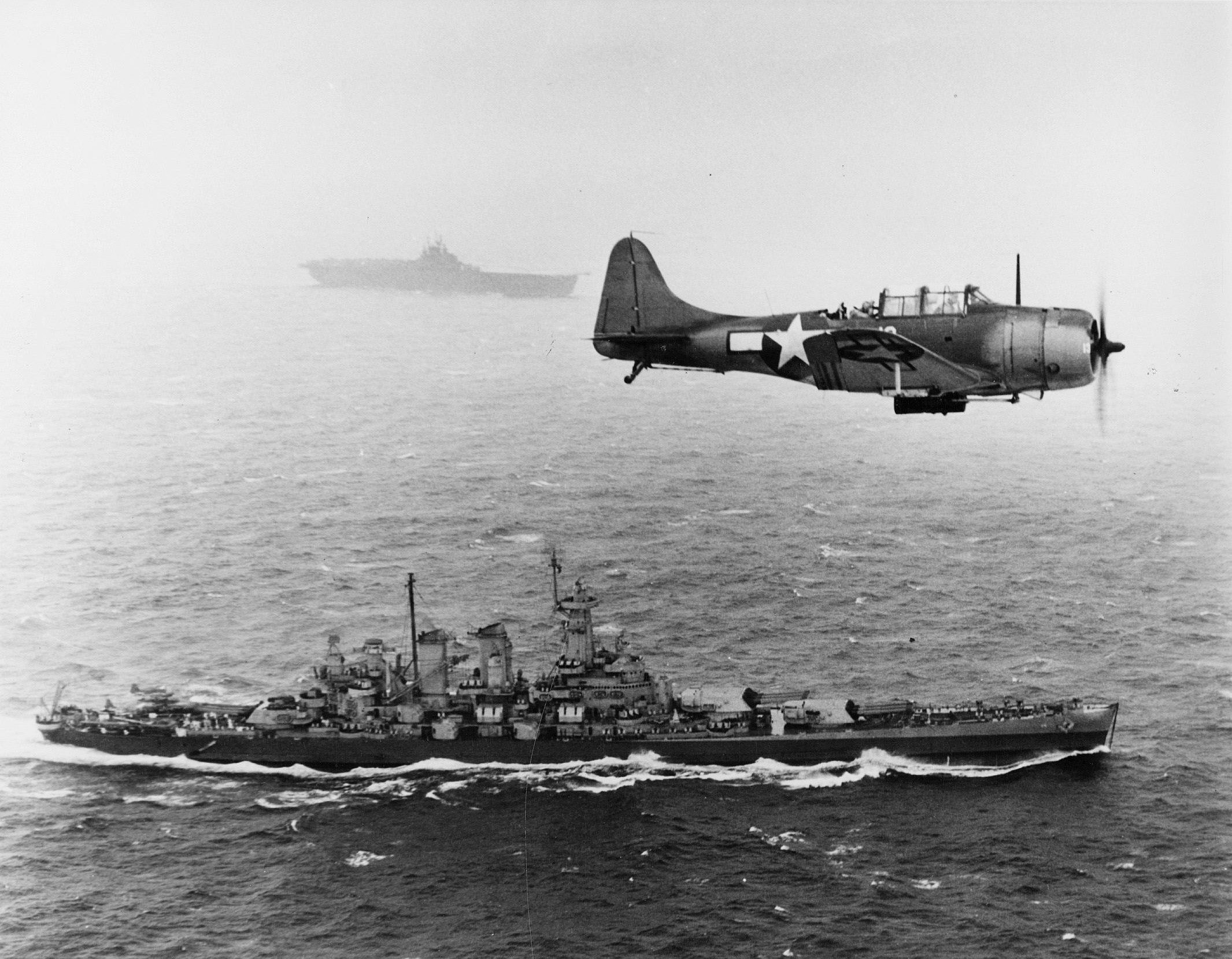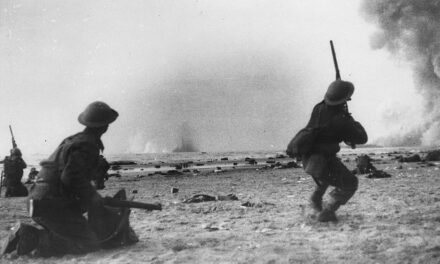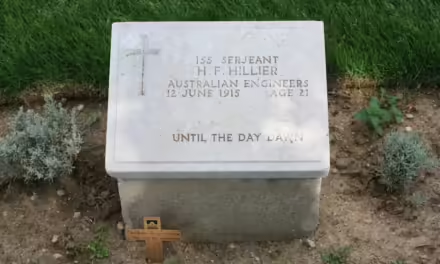Reading time: 98 minutes
Less than two months after the devastating surprise attack at Pearl Harbour, the US Navy was on the offensive. They carried out several raids on Japanese territory in the Pacific.
The Raid on the Marshall and Gilbert Islands
February 1, 1942
The first offensive operation by Task Forces of the United States Pacific Fleet in the current war took place just 8 weeks after Japan’s attack of December 7, 1941, against Pearl Harbor. The intervening period had been one of constant success for the enemy: Manila and Cavite fell on the 2d of January, Bougainville in the Solomons on the 22d, Rabaul and Balikpapan on the 23d.
These advances were the result not only of a matured and well implemented plan of campaign, but of the enemy’s ability to exploit the advantages accruing to him from his initial surprise attack. Moreover, commitments in the Atlantic contributed to the defensive role which was forced upon our Pacific Fleet.
Nevertheless, known movements of the enemy were carefully scrutinized, and the disposition of his forces considered in order that offensive action might be launched at the earliest moment.
The situation
During the first days of January, the pattern of these movements began to indicate that such a moment was approaching. Broadly stated, our own submarine reconnaissance and other intelligence indicated that the Japanese Fourth Fleet1 was based principally on Truk in the Mandates and that it had been reinforced by the Eighth Cruiser Division2 and the Second Carrier Division.3 A large number of enemy submarines were based on the Marshall Islands with the submarine fleet commander reported at Jaluit. However, many of these submarines were operating
in the vicinity of Hawaii and in the eastern Pacific. Also indicative of the trend of events were raids by cruisers, destroyers, and converted merchantmen which had been reported against four islands of the Gilbert group.
One island of this group, Makin, had been occupied by an unopposed force of Japanese as early as December 9th and had subsequently been employed as a base for their four-engined reconnaissance seaplanes. There also were indications that an air base was being developed there.
Thus, while the main Japanese naval units were still being employed against Borneo, the Celebes, and other islands to the west and southwest, there were clear hints that the next area of attack might well be to the southeast of the Mandated area. Such an attack might be launched in the near future against Samoa, where our positions were being reinforced by transports convoyed by Task Force HOW,4 Vice Admiral William F. Halsey, commanding, and Task Force FOX, Rear Admiral Frank J. Fletcher, commanding, or against Suva in the Fijis or Canton Island. Success in any of these operations could jeopardize the northeastern approaches to Australia and be of substantial assistance to any future attack which the enemy might launch against that continent.
It appeared to Admiral Chester W. Nimitz, who had become Commander in Chief, United States Pacific Fleet, on December 17, 1941, that the time had come for a damaging raid against the Marshall Islands before enemy strength was fully assembled in the Mandates. Task Forces, HOW and FOX, which would shortly complete a convoy operation at Samoa, were the logical units to employ in such an operation.
At that time, our information concerning the Marshall and Gilbert Islands was by no means complete. So far as the Marshalls were concerned, it was known that 2 landing fields, each with a hangar capable of housing 20 medium-sized planes, had been constructed on Enybor Island, just north of Jaluit. Camouflaged storehouses and gasoline and fuel-oil storage tanks were adjacent to these fields. On Jaluit, administration buildings and shore batteries were known to have been established along the three-quarter mile water front street, called the Marine Parade. It was also assumed that, given warning, the enemy could concentrate a considerable over-all strength for mutual support.
In order to observe Japanese activities in the area, a shuttle patrol of six Army B-17’s and six Navy patrol planes was established between Canton and Suva on the 19th of January.
PLAN OF ATTACK
On January 9th Admiral Nimitz directed Admiral Halsey to raid the southern Marshall and northern Gilbert area employing air attack and ship bombardment, the general priority of objectives being: combatant ships; aircraft, particularly those on the ground or water, and tenders; other ships; aircraft supporting installations; fuel tanks, power, and radio installations; troop concentrations; and storehouses. Our task forces were to depart from Samoa on the 25th of January.
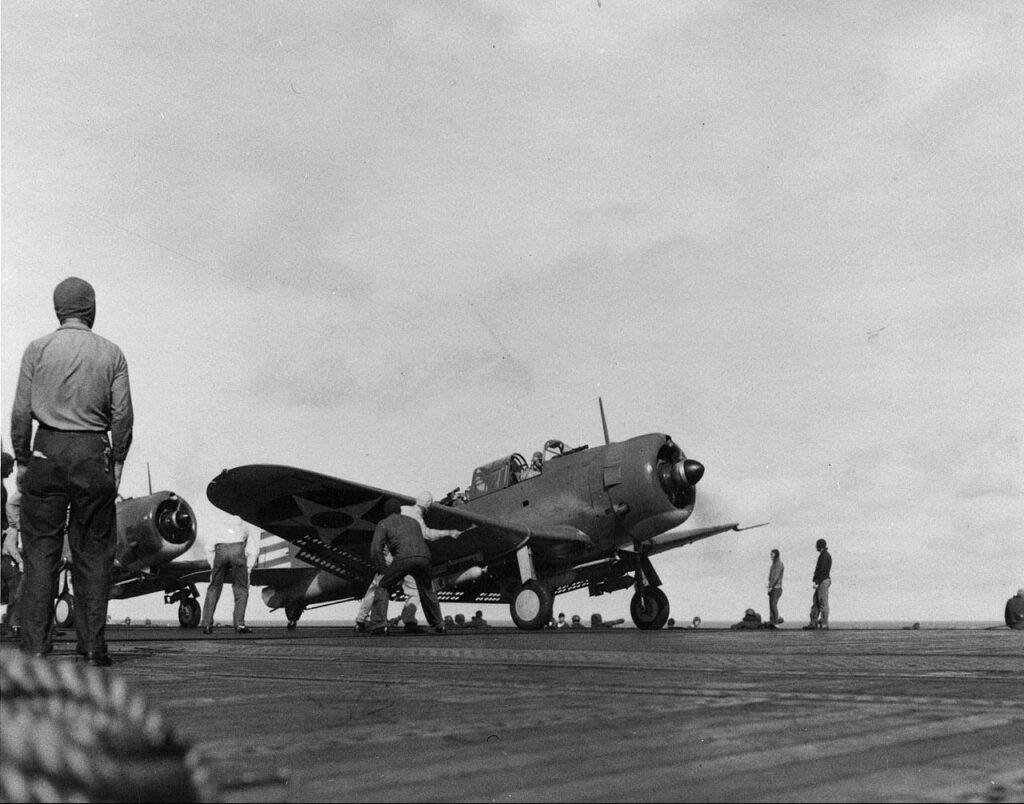
These forces were made up as follows:
Task Force HOW, Admiral Halsey commanding (Enterprise flag).
Striking group –
Wotje bombardment group, Rear Admiral Raymond A. Spruance commanding (Northampton flag):
Northampton, Capt. William D. Chandler.
Salt Lake City, Capt. Ellis M. Zachanas.
Dunlap, Lt. Comdr. Virginius R. Roane.
Maleolap bombardment group, Capt. Thomas M. Shock commanding (Chester flag):
Chester, Captain Shock.
Balch, Commander Charles J. Rend.
Maury, Lt. Comdr. Elmer D. Snare.
Carrier group:
Enterprise, Capt. George D. Murray. Support:
Ralph Talbot, Commander Ralph Earle, Jr.
Blue, Commander Harold N. Williams.
McCall, Commander Frederick Moosbrugger.
Fueling group –
Platte, Capt. Ralph H. Henkle.
Craven, Lt. Comdr. Allen P. Calvert.
Task Force FOX, Admiral Fletcher commanding (Yorktown flag).
Striking group—
Carrier group:
Yorktown, Capt. Elliott Buckmaster. Support:
Hughes, Lt. Comdr. Donald J. Ramsey.
Sims, Lt. Comdr. Willford M. Hyman.
Russell, Lt. Comdr. Glenn R. Hartwig.
Walke, Lt. Comdr. Thomas E. Fraser.
Louisville, Capt. Elliott B. Nixon.
St. Louis, Capt. George A. Rood.
Fueling group—
Sabine, Commander Houston L. Maples.
Mahan, Lt. Comdr. Rodger W. Simpson.
Upon departure from Samoa, these forces were to proceed to the vicinity northeast of Howland Island, for refueling on the 28th of January. On completion of this operation the Platte and the Craven were to proceed to Pearl Harbor, while the Sabine and Mahan, upon completion of the first fueling, were to proceed eastward in time for a second fueling rendezvous at a point about midway on the return trip, at 2000 on February 2d. The Sabine‘s approach to the second fueling point was to be from the southeastward to avoid possible contact with other units of the task forces during the preceding night.
TASK FORCE ATTACK PLANS
Task force HOW.
Further details of the plan, as they were later developed, required that the Enterprise launch the main air attack on Kwajalein from latitude 10°00′ N. longitude 170°00′ E. on February 1st, as near 15 minutes before sunrise at Kwajalein as practical. Simultaneously the bombardment group, composed of the Northampton, Salt Lake City, and Dunlap, was to shell Wotje, and the Chester, Balch, and Maury to shell Maloelap. Fighter planes from the Enterprise were to support the bombardment groups by strafing prior to bombardment. Attacks were to be repeated and other objectives attacked as developments warranted.
Enterprise air group.
The primary objectives for the Enterprise bombing squadrons were to be any ships found at Roi Island; or, if none were found, the planes were to proceed immediately to Kwajalein Island in search of enemy ships and to support the first division of the torpedo squadron. The Enterprise scouting squadron was to make a gliding attack to strafe and drop 100-pound bombs on the air field, planes on the ground, hangars, fuel tanks, and other installations on both Roi and Kwajalein. If suitable objectives survived, a second dive-bombing attack with 500-pound bombs was con-
templated. If suitable targets for a torpedo attack were found or remained after the horizontal and dive-bombing attack had been completed, the Enterprise was to be informed and the second division of the torpedo squadron was to attack with torpedoes. The fighter squadron was to make attacks on the fields at Wotje and Maloelap Island, six planes on each, while six other planes were to fly a combat patrol over the ship. Further attacks by all planes were to be made as conditions warranted.
Wotje bombardment group.
As a result of prior study it was believed that all Japanese shore installations would be found on the island of Wotje and that enemy vessels inside the atoll would probably be in the anchorage immediately to the westward of that island. This did not, however, preclude the possibilities that shore batteries might be located on outlying supporting islands, such as Egmedio, Ene Cherutakku, or Ormed, and that ships might be found using other anchorages, such as Ormed and Christmas Harbor, or attempting to leave or enter the lagoon.
In selecting the point from which to commence the bombardment and the courses to be steered during it, the following factors were given considerations:
(a)Priority of objectives. – Enemy ships were given first priority; they might get underway and move out of range. Aircraft on the ground were obviously important, but these were assigned to the Enterprise fighters. Also, the possibility of being able to bring enemy aircraft under effective fire from ships’ guns during the early stages of the bombardment seemed unlikely, as the location of the landing field was unknown. Wind data available for the Marshall Islands showed prevailing winds from northeast to east. If these data were accurate, the necessity for a good east-west runway would have placed the landing field on the north end of the island. 5 Shore installations were thus given second priority after ships.
(b) Location and strength of shore batteries. – It was believed that the largest caliber gun likely to be found on Wotje would be 6-inch with a maximum range of 20,000 yards; that the shore batteries would be on the seaward or eastern side of the island; and that enemy fire control would be most accurate on bearings between northeast and southeast
and least accurate to the southward. Batteries might exist, however, on Egmedio, Ene Cherutakku and Ormed Islands.
(c) Range of own batteries. – Our cruisers’ 8-inch guns would be effective to 30,000 yards, destroyer 5-inch to 15,000 yards, and cruiser 5-inch (dual purpose) to 12,000 yards. Concerning our 5-inch batteries, however, consideration had to be given to the difference in ranges to the shore line, where enemy batteries probably were located, and to the positions of shore objectives.
(d) Navigational and other conditions involved in the approach. – The sun would rise at 0702, bearing 110°. Cruiser aircraft should be launched as late as possible in order to conserve fuel, but early enough to permit them to be on spotting stations by 0715, yet not so close to Wotje that the flash from the catapult powder charges would alert the enemy. It was also undesirable for our ships to be silhouetted from Wotje on the eastern horizon before our fighters attacked. These considerations, the proximity of Erikub and Maloelap Atolls to the southward of Wotje Atoll, the low-lying nature of all land in these atolls and the fact that rather strong ocean currents were known to exist, all would require exceptional accuracy of navigation during the night.
The foregoing considerations resulted in the decision to approach Wotje from the southeastward, and to arrive at 0715 at a position 20,000 yards from probable shore batteries whence ships at the anchorage would be under direct observation; to maneuver by turn movements on courses to close the range while maintaining broadside fire, firing deliberately with 8-inch partial salvos on enemy ships and at the same time developing the location and strength of the shore batteries; and, finally to shift fire to shore objectives, closing the range, if possible, to permit the cruiser 5-inch to fire effectively. An approach from the southward of Wotje Island, rather than the northward, was selected because this covered Schischmarev Strait, the principal entrance to the lagoon, and the channel to it from Wotje anchorage. Moreover, for fire against shore objectives a position to the southward of Wotje Island was desirable because the major axis of the island is north and south.
Taroa bombardment group.
The attack on Taroa was to be carried out by a task group consisting of the Chester, Balch, and Maury. It was the intention of the group to pass through the initial point, bearing 116°, distant 10 miles from the
center of Taroa Island at 0715, February 1st. The approach was to be made with the Balch as guide, followed by the Chester and Maury at distances of 1,000 yards, on course 236° at a speed of 20 knots. The ships were to continue on that course with the Chester‘s main battery firing for about 20 minutes. Thereafter, if practicable the group was to close the range to permit effective fire of all 5-inch batteries. The priority of objectives would be as set forth in Admiral Nimitz’s order. If any enemy surface vessels were present and attempted to escape, the group was to maneuver to cover the entrance to Enijun Channel.
Task Force FOX.
Admiral Fletcher’s orders to his task force required that the striking group, which consisted of the Yorktown, Louisville, and St. Louis, and support, consisting of the destroyers Hughes, Sims, Russell, and Walke proceed in company to latitude 5° N., longitude 175°25′ E., arriving at 7 o’clock on the evening of the 31st. From this point the striking group was ordered to proceed at 25 knots on course 270°, while the support was to follow at a speed of advance of 15 knots until rejoining the striking group.
The striking group was to launch an air attack on Jaluit, Makin, and Mili from the Yorktown. The attack was to be launched at latitude 5° N., longitude 171°50′ E., after which the Yorktown was to retire eastward at 25 knots on course 090°. The attack was to be executed to strike about 15 minutes prior to sunrise; however, launching times could be advanced to permit attack and recovery of aircraft prior to daylight if weather conditions were propitious.
It was provided that if the support failed to contact the striking group at the expected time and place, support would continue on 270° for about 1 hour unless otherwise directed, and endeavor to locate the Yorktown. This search was not to proceed further west than 172°00′ E. Should the search fail to locate any units of the striking group and should no further orders be received, the support was to retire toward latitude 4°40′ N., longitude 170°00′ W., where it would pick up the fueling group, Sabine and Mahan, and return to Pearl Harbor.
ACTION OF THE ENTERPRISE AIR GROUP
Admiral Halsey’s task force proceeded at reduced speed throughout daylight hours of the 31st. Once during that time, there was an alert
when an enemy plane passed 35 miles astern of our rear ship, but it failed to detect the presence of our vessels.
After sunset, cruisers and carrier separated, speed was increased to approximately 30 knots by the carrier and 25 knots by the cruisers and, as the Enterprise came to latitude 10° N., longitude 170° W., the ideal weather and sea conditions which had prevailed throughout the night were still present. At 0443, when the first carrier plane was launched, there was little or no wind and a full moon was still above the horizon.
The position of the Enterprise in respect to the points of attack was as follows:
| Place | Bearing from Enterprise | Distance in miles |
| Roi Island | 256 | 154 |
| Kwajalein Island | 240 | 156 |
| Taroa Island | 136 | 106 |
| Wotje Island | 156 | 36 |
The launching of the first group, which consisted of 36 scout bombers, each carrying one 500- and two 100-pound bombs, was completed and at 0508 nine torpedo bombers and an additional scout bomber were put into the air. All these planes, which were detailed for Kwajalien and Roi Islands in the Kwajalein Atoll, took their departure at 0630 with Comdr. Howard L. Young, the Air Group Commander.
Fifteen minutes later, the planes for Roi were estimated to be 20 miles northeast of the island. From an altitude of 15,000 feet, the tip of the sun could be seen rising above the horizon just as the moon was setting. These conditions should have afforded good visibility at sea level, but the horizon was shrouded in mist so that a small strip of land which was observed at 0653 was not identified as Roi Island until 5 minutes after 7. This was due, also, to our planes being equipped only with small photostatic maps. No ships or other signs of activity were observed.
The scouting squadron, which was in a three-division formation, was ordered to attack. At almost the same moment, the air group commander received word from our planes over Kwajalein via the Enterprise that there were numerous ships, including “two carriers” in that area. He immediately detached his bombing squadron to assist in dealing with that situation.
The first division of the scouting squadron began its glide-bombing attack from an altitude of 14,000 feet, 15 miles north of Roi. Because of the paucity of prior information, the selection of targets was left to the discretion of each pilot.
While the first division was approaching the target area, the second circled the island close aboard, in order to open out on the first. During the course of this maneuver, it was seen that enemy fighters, perhaps aroused by the first passage of our planes near the island 20 minutes earlier, were coming in to attack. A considerable amount of antiaircraft fire was rising.
The second division therefore moved on the target area at a higher speed (200 knots) than the first and from an altitude of 10,000 feet. The third division followed closely, and like the others, most of the planes released their 100-pound bombs. Some, in all three divisions, also dropped their 500-pounders.
Meanwhile additional enemy planes had joined those already in the air with the result that numerous individual fights ensued. Our planes succeeded in destroying 3 enemy fighters, while the Japanese were seen to shoot down 2 planes of the scouting squadron, one of which was in flames. In addition, we lost one plane probably to antiaircraft fire and another to causes unknown. This fourth plane was last seen making what appeared to be a controlled, but extremely fast, down-wind landing on the water about a mile north of Roi.
Some of our planes succeeded in making a second attack on the shore installations of the island. When these operations were completed seven of the squadron proceeded to Kwajalein and the balance returned to the Enterprise.
Commencing 0508 nine planes of the torpedo squadron were launched from the Enterprise, each loaded with three 500-pound bombs with 1/100″ delayed action fuses. Objectives were combatant ships, valuable surface ships and shore facilities at Kwajalein Island. Weather conditions were good, low scattered clouds at 3,000 feet, three- to four-tenths overcast, unlimited ceiling. Wind was from the east-northeast at 15 knots.
Landfall was made at Kwajalein and attacks were begun against nine cargo ships, two four-engine planes, and a large compound on the island. The first bomb was released at 0658; the last at 0711. Sufficient additional targets to warrant use of aircraft torpedoes were at anchor in the lagoon and report was so made to the Enterprise via voice radio. The antiaircraft fire met by the torpedo squadron was intense and more accurate than had been expected. No enemy aircraft opposition was encountered. The squadron departed from Kwajalein at 0717 and landed aboard the Enterprise at 0935.
As has already been noted, the Air Group Commander at Roi Island, having received the report of the presence of enemy ships at Kwajalein, ordered the 10 scout bombers which were at Roi to proceed to Kwajalein. At 0705, these bombers began a southward movement down the middle of the lagoon, searching for enemy ships. They arrived off Kwajalein 20 minutes later at an altitude of 14,000 feet.
The light and visibility were sufficient at this time to reveal that the ‘two carriers’ previously reported were, in fact, large merchant ships.
As the squadron approached the target area, an umbrella barrage of 3- to 5-inch antiaircraft was sent up, with fuse setting at 10,000 feet. This barrage was directly over the anchorage and was not directed at our approaching planes. At the same time heavy machine-gun fire was noticed, which was an utter waste of ammunition. Although there was some large caliber antiaircraft fire from shore guns, the greatest volume of fire came from an antiaircraft cruiser in a central anchorage position. This cruiser was armed with 12 or more large caliber and numerous small caliber antiaircraft guns, and at least 1 multiple pom-pom.
Because the squadron was cruising in a three-division attack formation and squadron doctrine thoroughly covered the situation, a single signal was all that was necessary to launch the attack. This signal was given at 0727 and the divisions separated and each section chose a target. Normal dive-bombing approaches were used and 500-pound bombs were dropped. In several cases individual pilots, not satisfied with their dive, or observing previous hits on target selected, pulled up and chose another target. As radical evasive action was required to escape the great volume of machine-gun fire, planes became separated and each pilot made his subsequent attacks individually. In these subsequent attacks, glide bombing and strafing were employed against smaller ships, large sea-planes, and the shore installations. No enemy aircraft were encountered in the air.
Having completed this mission, the bombers returned to the Enterprise at 0900.
At 0731, while these planes were over Kwajalein, nine torpedo planes, armed with torpedoes, were launched from the Enterprise and proceeded directly to the island, which due to the carrier’s movements, was now on track 245°, distance 180 miles. While en route, these planes were advised that their attack should be initiated from the north and as a consequence, course was altered and the planes arrived off Bigej Channel at about 5 minutes after 9. Antiaircraft fire was immediately encountered at 1,200 feet. The group was in a close echelon of V‘s at this time.
Several large auxiliaries anchored in parallel lines lying approximately east and west with oilers in the northernmost line, cargo ships and troop transports in the next line were observed. Light vessels of tender type were anchored close in to the island and about a dozen patrol type vessels were maneuvering around the lagoon to the north of the line of oilers.
The pilots were informed that the first plane would take the first large vessel to the east and the other planes were to assume large objectives working toward the west in rotation. The formation, in a right echelon of echelons was then at 500 to 700 feet just passing over the reef bordering the lagoon to the north of Bigej Island. Intense antiaircraft fire from 5- or 3-inch guns and pom-poms was now being encountered. The formation was broken up and the attack initiated. It was necessary to pass over numerous small vessels of the gun boat type and skirt vessels beached along the lagoon. All of these vessels maintained an intense machine-gun fire. Large vessels were using pom-poms as well as 3- or 5-inch antiaircraft guns. Antiaircraft guns along the island or edge of the lagoon were also firing. At about this point a light cruiser was noted limping out of the anchorage toward the south pass. Three planes were ordered to concentrate on the cruiser. Planes were now rapidly closing on the first line of ships. Planes releasing on these targets dropped their torpedoes at about 400 to 500 yards and then zoomed over their targets and retired to the east. Planes with targets in the second line dropped torpedoes after maneuvering over or through the first line and then they, too, retired to the east. The planes concentrating on the cruiser maneuvered to box him in, dropped their torpedoes and retired to the north.
While the enemy antiaircraft fire was intense and sustained, it was haphazardly controlled. It is believed the enemy’s antiaircraft inflicted considerable casualties on themselves: the second line of ships firing into the first line and shore guns firing into all ships. It was noted that a vigorous dive on a gun crew dispersed it even though the attacking
plane did not fire. One attempt was made to strafe patrol planes and facilities on Ebeiye Island, but this failed due to a gun jam. All radiomen maintained a vigorous fire with free guns during the approach and the retirement.
A rendezvous was effected about 10 or 15 miles east of Kwajalein Island. While circling for the join-up, it was noted that large caliber shells from shore batteries were falling in the water around the formation. The attack group returned to the ships, arriving at about 1130. Bullet and shrapnel holes were found in three of the returning planes, but no crew members were injured.
All torpedoes appeared to have run satisfactorily; however, one of the torpedoes launched at the cruiser exploded before reaching the ship, probably on a coral head.
Fortunately, in this action Torpedo Squadron SIX encountered no air opposition, but it is certain that their mission would not have been accomplished had they been intercepted by enemy fighters which were in the near vicinity.
Beginning at 0610, five fighter planes, each equipped with a 100-pound bomb, left the Enterprise to carry out strafing attacks on Taroa Island in the Maloelap Atoll. A sixth plane crashed in taking off.
The group reached its goal and observed that a new airfield had just been completed. Its two 5,000-foot runways and installations, compared not unfavorably with that at Ford Island, Pearl Harbor. Had this field been in full operation, the position of the task force might have been seriously jeopardized. Numerous planes were observed on the ground. These and the installations were attacked until a quarter after 7.
During their time over the island, our fighters were attacked by an enemy patrol and considerable antiaircraft fire. Two of the Japanese planes were shot down by Lt. James S. Gray, Jr., and one by Lt. (j.g.) William E. Rawie. It is believed that one enemy plane was destroyed on the ground and that many more would have been put out of action had our planes been provided with incendiary bullets.
All five of our fighters returned to the Enterprise.
At 0935, nine scout bombers which had landed at 0900, after having taken part in the dawn attack on Kwajalein, were launched for a second attack on Taroa Island. This group was composed of seven planes of
the bombing squadron and two planes of the scouting squadron. At the time of the launching the Enterprise was about 95 miles from the objective. Emergency departure was taken and rendezvous was effected en route. Flying in three three-plane sections, the group climbed until an up-sun position about 30 miles to the southeast of Taroa Island at 19,000 was reached at 1032. At this time, and from this point, a high-speed nose-down approach was commenced directly towards Taroa. The group remained closed up in a modified division V formation (one wing section high and one wing section low) for mutual defense against enemy fighter aircraft, which were reported to be plentiful in the vicinity of the target. When about 6 miles from the target, the sections were released and when almost at the dive point the individual planes of each section were placed in an opened out ABC 6 formation in a generally north to north-west direction. Flaps were opened and vertical dives made from 13,000 feet altitude directly over the flying field at Taroa. No fighter opposition and no enemy antiaircraft fire was encountered prior to the attack. The island showed no signs of having been previously bombarded. The hangars and buildings were new, uncamouflaged, undamaged, and the planes were lined up in neat rows. About 12 two-engined bombers were parked in a single row on the edge of the north south runway, 5 fighters were parked in front of the north hangar and 6 fighters were parked at the south end of the north-south runway. Two bombers were parked to the northeast of the runways and were well separated.
The first section leader dropped a ripple salvo of two 100-pound and one 500-pound bombs, aiming at planes parked on the field. His bombs destroyed two large bombers and set two others afire, there being little doubt that the last two were ruined. Three small fighter planes were also seen to catch afire from these bombs. The second plane dropped a 500-pound bomb on the southernmost of two hangars near the field making a direct hit. The hangar must have contained gasoline as it went up in very high flames after the bomb explosion. The hangar was apparently a total loss. This plane then headed for Ollot Island where the pilot attacked what appeared to be radio towers and an administration building or barracks and a small radio station or powerhouse. He dropped two
100-pound bombs in salvo, hitting one corner of the large building and the small house. The third plane dropped one 500-pound and two 100-pound bombs about 20 feet in front of the northern hangar. Three fighter planes in front of the hangar were demolished.
The second section leader dropped one 100-pound bomb from 9,000 feet at planes parked on the field. This bomb hit alongside a large bombing plane, which was demolished and two fighter planes were seen to catch on fire. He then dropped his 500-pound bomb on an oil storage tank to the southeast of the hangars, making a direct hit and setting it on fire. He headed for Ollot Island and dropped a 100-pound bomb on an anti-aircraft gun emplacement there. The bomb explosion was followed by puffs of white smoke, possibly indicating that ammunition was exploding afterward. The second plane of this section dropped all his bombs in the initial dive, but was unable to observe where they hit due to pulling out fairly low. The third plane dropped all his bombs on a T-shaped building that was apparently a barracks or administration building. A direct hit opened the building up about half way down the stem of the T. These two planes then strafed a small boat seen proceeding toward a pier on Ollet. Another plane was attacked by a fighter just after pulling out of the strafing run. He did not have time to announce the fact over the radio and was forced to take evasive action by himself. The enemy fighter did not push his attack home, but seemed willing to display the maneuverability of his plane and fire outside of gun range. The pilot was able then to evade him and eventually to make a safe getaway and return to the ship alone undamaged.
The third section leader dropped his 500-pound bomb on the southern hangar making a direct hit. This was the second direct hit with 500-pound bombs on this installation. He then dropped his two 100-pound bombs in salvo at the planes parked on the field. They hit in the middle of the northeast-southwest runway in the vicinity of the planes, but no damage to the planes was apparent. The second plane of this section dropped all his bombs in ripple salvo in the dive, aiming at the northern hangar, but was unable to observe the drops because of pulling out low. No bombs were seen to hit the northern hangar, however. The third plane also unloaded at the northern hangar, but his bombs all dropped between two hangars causing no damage apparent from the air. This third section retired to the northward, and when the section leader was about 6 miles north of the field a fighter dove on him. He escaped
without further incident with no bullet holes in his plane. Here, again, the enemy fighter pilot seemed content to display the greater maneuverability of his plane and did not drive home his attack.
Throughout the attack no antiaircraft fire was encountered, except machine-gun fire after the first section planes entered their dive. All sections dived through the machine-gun fire, but only one small hole in the right aileron of the second section leader’s plane was found. Antiaircraft fire from several guns on Taroa and from four or five on Ollot Island was observed after the attack. This fire was rather sporadic and inaccurate at first, each gun apparently trying to select its own target. When the flight leader was about 5 miles on his retiring course, however, the batteries appeared to concentrate on his section and the fire became fairly accurate. The planes had inadvertently put themselves in a position to be enfiladed while joining up on the flight leader. When all planes dove for the water the fire again became very ineffective and ceased when the retiring planes were about 8 miles away. Seven planes returned together; the two that had been attacked by fighters returned singly and joined the group just prior to landing aboard.
At 1015 nine bombing planes were launched for a third attack on the island. This group was composed of eight planes of the bombing squadron and one plane of the scouting squadron. Departure was taken immediately and course set for Taroa.
The group climbed steadily, swinging to the east in order to make an attack out of the sun or down wind (090° true) when about 15 miles off shore on course a little north of Taroa, the attack group levelled off at 13,000 feet gaining speed and then swinging toward the south. Shortly thereafter two two-plane sections of enemy fighters were seen turning toward us. Accordingly, our formation turned (toward Taroa) and went immediately into column thus sacrificing mutual firepower support for better observation of possible targets. This turn placed the enemy fighters broad on our starboard bow, but as our group, in order to gain speed, went into a 200-knot power glide, the enemy held altitude. Presently, they attacked, following our planes down.
Simultaneously, bursts of antiaircraft fire were seen at 10 to 12 thousand feet over the field which was still 7 or 8 miles distant. Course was altered in the hope of confusing the ground batteries which it was thought would soon be brought to bear. However, as our group arrived just
–15–
north of the field, we observed that this fire was in the nature of a fixed umbrella, and consequently did not seek out individual targets.
Our planes were now in diving position. Just as they were about to push over, the pilot of plane B-15, the last in column, flew under and ahead of B-12, the next in line. The pilot of B-12 saw that the reason for this maneuver was an enemy fighter on the tail of B-15. B-12 opened fire with his two fixed guns, and shot down the fighter.
The leading planes attacked the hangars and area close by, while those following selected the large bombers on the field. All except B-10 dropped their bombs in ripple salvos on the first dive. During the pull-out the planes were immediately engaged by what must have been a low level fighter patrol. The action broke up into individual dog fights, during which two enemy fighters were shot down. It was during this phase that B-15 was last seen dodging into a cloud with a pursuing enemy fighter. All planes were attacked at least once by fighters and had to make defensive use of the excellent cloud layer at from 2 to 4 thousand feet.
Enemy fighters encountered were types 96, 97, and, in one instance, Zero fighters. The 96 and 97 fighters could outmaneuver our aircraft, including the F4F’s (Grumman Fighters), and appeared faster than the SBD’s (Douglas Scout Bombers). The F4F’s were much faster and had more gun power than the enemy planes, but the pilots of Fighting Squadron Six made no attempts to engage in dog fights as soon as the maneuverability of the enemy fighters became apparent. No information was obtained on the relative performance of the type Zero fighter and the F4F-3.
A group of six fighter planes destined for Wotje Island were launched immediately after the first group which attacked Taroa. All planes were in the air by 0616.
It was anticipated that this island would prove the most fully developed from a military viewpoint. For this reason, the main attack was built around bombardment by the Northampton, Salt Lake City, and Dunlap beginning at 0715.
The first attack by the fighters was unopposed, their second was met by antiaircraft fire. The planes left the island before the beginning of the bombardment.
Later in the day, at 1116, a second group consisting of eight scout bombers, each carrying one 500- and two 100-pound bombs, and nine torpedo planes carrying three 500-pound bombs, were launched, and delivered an attack on the few targets which had survived the bombardment. The airfield and its facilities were completely destroyed while only two of the original eight or nine ships in the harbor could be seen.
ACTION OF THE WOTJE BOMBARDMENT GROUP
At 1830 January 31st, the task group consisting of the Northampton, Salt Lake City, and Dunlap, Rear Admiral Spruance commanding, proceeded toward Wotje Island on course 258° true at a speed of 17.3 knots.
At 0620 February 1st, the ships were turned into the wind for launching the aircraft. Just after the cruiser planes were catapulted the presence of our task force was signaled to the shore by a rocket fired from a patrol boat of about 800 tons. The Dunlap was designated to sink the boat which went zigzagging away. Only the bow gun of the destroyer would bear, so she had some difficulty hitting her fleeing, low-freeboard target.
Upon completion of the launching, the planes from the Salt Lake City and Northampton rendezvoused as a unit and proceeded to the north of the island of Wotje. The reconnaissance and photographic planes broke off and headed south to photograph the straits and reconnoiter, passing clockwise around the atoll. At 0653 the antiaircraft guns on the island opened fire on the fighters from the Enterprise and a few minutes later shifted fire to the spotting planes. Spotting stations first were taken up north of the island.
At about 0655 the ships of the task group sighted land on the starboard bow. It consisted of numerous low-lying islands, with the island to the extreme right, Wotje, having what appeared to be two radio towers of medium height and various fire control and lookout masts. Upon closer observation one large ship was seen in the lagoon and within a very few minutes the stacks of about five others came into view. Many of the ships were showing black smoke indicating that they were lighting off. An initial report of “three ships and no shore batteries” was received from the reconnaissance group. Subsequently, it was learned that actually eight ships and five batteries were present. Such incomplete information could have caused disaster.
When the range to Wotje was about 24,000 yards, three large freighter type ships could be seen. The left-hand ship was clearly visible and was the normal target for the Northampton. The Salt Lake City control officer designated the right-hand auxiliary ship for his target.
At the commencement of the bombardment at 0715, 13 minutes after sunrise, the cruisers were in column on course 270°, with the Dunlap screening ahead and having under fire the Japanese patrol vessel. Thereafter, the Dunlap operated independently, sinking the patrol vessel, then searching to the westward for two submarines reported to be standing out of the lagoon, and finally following the cruisers on a northeasterly course, bombarding Wotje Island.
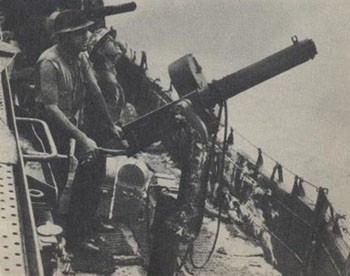
The Northampton opened fire with a full salvo. The control officer on the Salt Lake City had been ordered by his captain to follow the movements of the flagship in either single turret or full salvo fire. About 20 seconds later the Salt Lake City opened with a full salvo, slow fire. After the second salvo, it was observed that the Northampton was firing single-turret salvos, so the Salt Lake City control ordered single turret salvos, slow fire, to economize ammunition.
The targets for our cruisers for the next 55 minutes were cruisers in the lagoon. Target designations against the enemy ships in the harbor partially hidden by high spots of land, some getting underway, and all changing relative positions with his own ship’s movement, proved a difficult problem for our control officers. Our air spotter had trouble attaining good spotting positions because of clouds and enemy antiaircraft fire. Rangefinders, due to their varying heights, had different views of the partially hidden ships. The problem of locating target designations was finally solved by giving the plane spotter the best possible description of the target in order to identify it.
An example of the difficulty that confronted Admiral Spruance’s Task Group can be shown by relating what happened when an enemy ship was placed under fire at about 0753 by the Salt Lake City.
When one of the Salt Lake City‘s targets became hidden from view, fire was shifted to a ship of about 4,000 to 5,000 tons which was pouring black smoke from its funnel and obviously trying to escape from the lagoon. The enemy’s speed was between 12 and 15 knots. It seemed that this vessel might be either a submarine tender or seaplane tender. Apparently she had three small deck guns which were being fired. In opening on this ship, the Salt Lake City crossed fire with the Northampton who at that
time was shooting at a target farther to the right, but this was believed best in order to prevent the ship’s escape. The target maneuvered radically, seeking as often as possible to place an island of the atoll between our cruiser and herself. While behind an island she would often reverse her course. The plane spotter for the Salt Lake City was having difficulty with clouds, so that each time the ship again came into view there would be another rangekeeper set-up necessary. Each time the target got behind an island, fire was checked.
At about 0803, the Salt Lake City and the Northampton reversed course from 270° to 060°, and the target came into clear view. Also, by this time, the plane spotter had obtained good spotting position over the lagoon and sent in satisfactory information on the target maneuvers and spots. Control ordered full 10-gun salvos, but maintained slow fire. The gun range was 15,900 yards. The first salvo landed on in deflection and just over, the spot D 300, left 1 mil. The next was a perfect straddle. The next salvo was a similar straddle. The enemy ship was extremely fortunate to live through those two salvos. The plane observers later reported that it was unbelievable that she was still visible when the splashes cleared away. The next salvo landed 7 mils right but was not spotted. The next was another perfect straddle. The target commenced to go down by the bow; however, she then appeared to steady and hold her own, so the Salt Lake City control officer ordered, “Give her another good one.” This fell slightly off to the right in deflection and control ordered, “One more and make it good.” No spot was made when this final salvo landed, but the target was perfectly centered in the splashes. Just before this salvo hit, the target commenced to go down rapidly by the bow and when this salvo landed a great flash appeared in the superstructure just below the bridge. The final gun range was 13,850 yards. The target sank at 0812.
During this time return fire from shore batteries and some of the enemy auxiliaries was observed, but their shots landed short of our vessels.
At about 0810 the Northampton and the Salt Lake City shifted their fire to shore objectives on Wotje. The extent and perfection of the camouflage used by the Japanese on their shore installations made spotting from the ships very difficult. Gasoline tanks were painted green and were covered on top with sod. Other installations such as buildings were often painted to resemble sand dunes. Many of these buildings were discovered only because of the shadow they cast in the sunlight.
The distinct handicap under which a task force operates when there is no prior specific information known regarding objectives for bombardment can be shown by relating in some detail the account of the Salt Lake City‘s shelling of a group of aircraft installations.
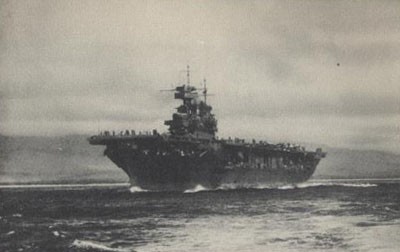
A group of buildings, some of which appeared to be hangars, were observed some distance from the beach. Eight buildings, painted to resemble sand dunes, were counted by the spotter with no trouble. However, the director pointer and trainer, with lower powered optics than the spotter, could not pick up any of these buildings through their telescopes. To the right of these sand-colored buildings was a group of smaller buildings painted a deep green. Since the director pointer and trainer were able to see these green buildings, they were ordered to use the left group of the green buildings as a point of aim. An arbitrary spot of left 5 was put on the rangekeeper to cause the shots to fall in this aviation center. But, the rangekeeper operator was not notified that the target had been shifted, and the left 5 was applied to a left deflection accumulated spot remaining from the previous target, so the first salvo landed well to the left of the hangars. There was no observation on that salvo. Another was fired with the same set up and a rich orange flame leaped into the air from among the palm trees to the left of the aviation buildings. Then the error on the rangekeeper was corrected and the next salvo was a little off to the right and another heavy fire was observed to start. The control officer next ordered full 10-gun salvos. The first landed among the aviation buildings followed by another salvo close to the same place, and it is believed considerable damage was done. A spot of right 03 was given, and our shells landed among the green buildings that were being used as the point of aim. The gun range at this time was averaging 11,800 yards. Later reports from the aviators revealed that this salvo did immense damage to industrial plants.
The enemy opened fire at 0721, using guns on one of the ships in the atoll. It was not until 0842, however, that shore batteries began to be effective. At that time shells burst close to the Salt Lake City. The ship increased speed and turned away but shells from two guns, probably 5 inchers, burst just astern. At 0848, the Northampton was straddled but although the enemy continued firing for another hour, his efforts were ineffective.
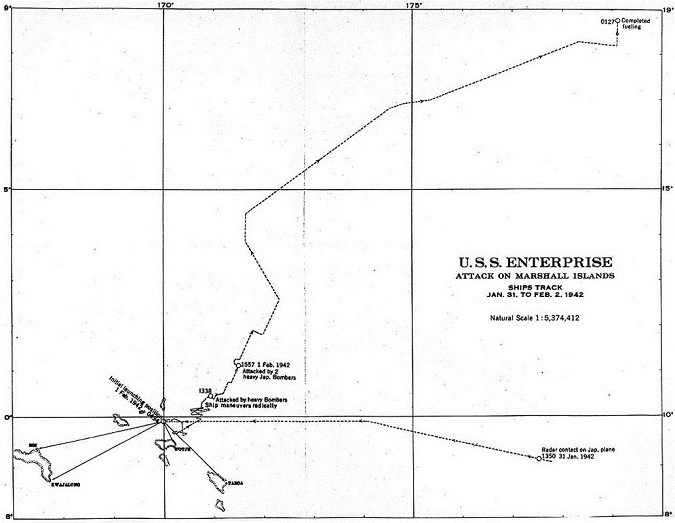
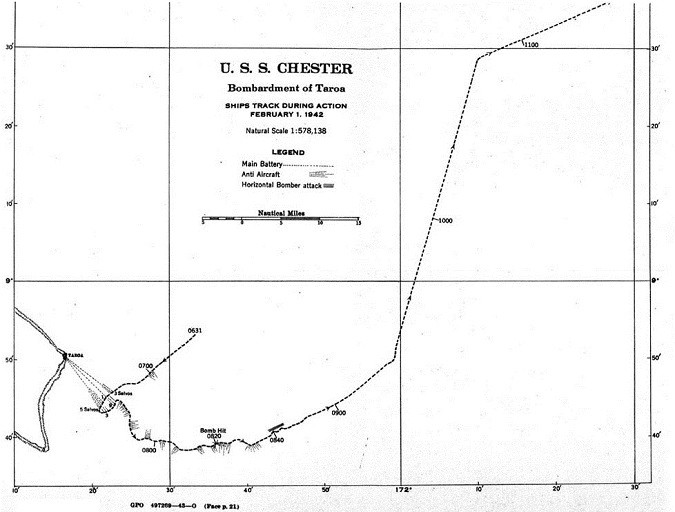
At 0852 the flagship ordered “Cease Firing” and the planes from the Northampton and Salt Lake City were ordered to attack the remaining objectives with the two 100-pound bombs that each plane carried.
The task group withdrew and commenced recovering their aircraft at 0955. During recovery one plane from the Salt Lake City crashed into the side of the ship. The Dunlap rescued the pilot and his radio man uninjured and then sank the plane with machine gun and rifle fire.
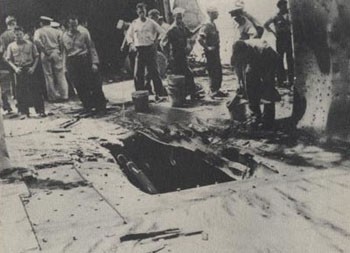
Rendezvous was made with the Enterprise at 1230 and course of 070° was steered at a speed of 25 knots. At 1335 and again at 1535 the task group opened fire on enemy planes that were making an attack on the Enterprise.
This task force suffered no damage or casualties as a result of enemy action. The 5-inch No. 8 gun on the Salt Lake City was damaged by a shell bursting in the muzzle and a slight bulge was found in gun No. 6 when the 5-inch guns were bore-gauged on February 2d.
ACTION OF THE TAROA BOMBARDMENT GROUP
Four Chester planes were launched at 0600, two for spot and two for reconnaissance. Taroa Island was sighted at 0649, range 28,500 yards.
At 0659, two enemy dive bombers attacked, dropping their bombs well clear. Shore batteries fired at the Chester at 0710. Their location could not be discerned, but the splashes indicated 5- or 6-inch guns. Fighters from the Enterprise could be seen strafing the island.
At 0715, the Chester opened fire with the main battery, using the towers on the northwest corner of the island as the point of aim. No air spot was available as our spotters were under attack. Almost immediately a second attack by enemy dive bombers was made. After 0715 the shore batteries kept the Chester under scattered fire. Suddenly, when the point of aim was shifted to the shore batteries, the range dropped to 12,000 yards, well within the range of shore batteries. The group immediately turned away 30° to open range. Lack of topographical knowledge of the island had thus brought about a potentially dangerous situation. Five additional salvos were fired at the shore batteries apparently silencing one, while the ship was under air attack.
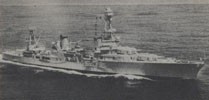
With the Chester still in range of the shore batteries and only two small auxiliaries visible in the lagoon, a left turn was ordered at 0731 to reverse the course. On the new course the main batteries resumed fire on the shore-line batteries, working north toward the hangar and airfields. The Balch was taking the center of the island under effective fire.
Nine minutes later eight twin-engined bombers were seen taking off from the island and a speedy retirement was now in order. Course was changed to 130° and then to 184°, speed was increased to all possible, and the main battery was ordered to cease fire and send personnel to assist the antiaircraft battery.
Until 0900 many dive-bombing and strafing attacks were made on the group, with the Chester being the principal target. The cruiser was able to avoid the bombs by changing courses until 0820 when one 134-pound bomb hit the well deck near the port catapult tower. The narrowest escape from serious damage or sinking came at 0841 when eight bombers dropped 500-pound bombs from 12,000 feet. These fell about 100 yards astern. Thereafter, air attacks slackened. Maximum speed was maintained, but no attempt was made to close the Enterprise since it was necessary to avoid indicating her direction to the enemy. At 1130 the Chester‘s four aircraft were recovered.
The following damage was inflicted by this task group:
- One plane destroyed in dog fight over the island, one probably destroyed by antiaircraft fire.
- Three shore batteries and one antiaircraft battery silenced.
- Three or four fires started, one probably an oil tank.
- Several buildings and one observation tower destroyed.
- One radio tower damaged.
Damage and losses sustained by this group:
- Casualties – 8 killed, 2 seriously injured, 9 injured and 23 slightly injured.
- The bomb which hit the Chester, estimated to have weighed 134 pounds, made a hole 9 by 4 feet in the main deck and did much superficial damage to blower screens, ventilation trunks, catapult catwalk, deck stanchions, and practically all light bulkheads in the line of the blast. It also dished in the catapult foundation about 1 foot, seriously damaged the port motor whaleboat, and started a fire in the cork insulation of the exhaust duct from the forward engine room.
The enemy lacked aggressiveness and failed to press their attacks home. In most instances, the dives made against the Chester were at about a 45° angle. Release was high (about 4,000 feet) and recovery was made by an abrupt pull-out with a steep turn. The enemy reluctance to close in for
attack in the face of our (antiaircraft) fire resulted in erratic bombing. A few planes were seen to jettison their bombs at some distance from our ships. Only one determined dive was seen. The enemy came in at 70° or better. His plane pulled out at about a 1,000-foot altitude. This plane scored the only hit. The same plane had previously made a very steep dive that resulted in a near miss. He then pulled out, climbed rapidly, executed a split “S” and returned for his hit.
The enemy dive bombers used cloud concealment at about 8,000 feet altitude very effectively in making their approach.
On all attacks on the Chester‘s reconnaissance planes, the Japanese fighters maneuvered to gain position directly overhead. They executed a half roll and steep dive. In no instance did they close to effective range. Their pull-outs were high and abrupt, resulting in scattered and inaccurate fire.
Enterprise retirement.
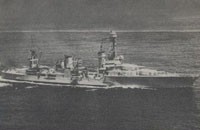
Combat patrols were flown throughout the day, covering the retirement of the Enterprise. During the early afternoon, five twin-engined bombers (some persons who saw the attack insist a sixth plane peeled off from the formation and dropped bombs in the vicinity of the Salt Lake City) were intercepted by the combat patrol. The enemy approach was made from the starboard bow from a position angle of 25°. The planes broke through the clouds, in a glide attack of about 20°. The first range finder range, about 3 seconds after breaking through the clouds, was 3,500 yards, altitude 6,000 feet. The enemy bombs were dropped at about 3,000 to 4,000 feet and the planes passed over the Enterprise at about 1,500 feet after dropping. The planes simultaneously dropped three bombs each, of about 100 to 200 kilograms. The nearest bomb hit about 30 feet from the port side of the Enterprise and it was later found that there were about 13 holes in the gasoline line in the vicinity of this near hit. A great quantity of gasoline from the punctured fuel line sprayed out on the walkway, saturating the rubber mats which burnt like cellophane. One of the enemy bombers peeled off from the formation after passing over the ship and made an effort to either strafe the planes on deck or crash into them; the pilot was either killed or lost control of his plane due to the heavy machine-gun fire, and crashed onto the deck and over the side. His wings struck the tail of one of our planes, damaging it so severely that it was partially stripped and shoved overboard.
At about 1500 a twin-float seaplane was intercepted and the plane was disabled by machine-gun fire. The pilot of the enemy plane attempted to parachute, but crashed into the sea.
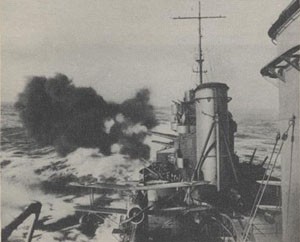
In the late afternoon two two-engined medium bombers were discovered making an attack at high altitude (14,000 feet) in level flight, speed 140 knots. These planes were originally sighted on the starboard quarter at a range of more than 50,000 yards. They were tracked all the way to the port quarter, range about 70,000 yards. They then made their approach from the sun and through large scattered clouds. At the time they were sighted coming in, the range finder was unable to get a range due to the smoke gasses. Fire was opened using the set-up obtained from tracking, the position angle when opening fire was about 45°, and slant range 6,500 yards. Two bombs, each weighing 500 pounds or more, were dropped from each plane simultaneously. One of the fighter patrol planes, which was close to the enemy, reported that our shots were short. A spot of Out 500 was applied, and a report was then received that Enterprise guns were on. A long trail of smoke was still visible when the plane disappeared into the clouds. The other enemy bomber was shot down in flames by our fighter plane patrol.
The performance of our ship’s antiaircraft batteries, on the occasion of the first attack to which she was exposed, was expectedly erratic; nevertheless, the effectiveness was so negligible as to give rise to grave anxiety. In the case of the first attack on the Enterprise particularly, properly controlled antiaircraft fire should have taken a heavy toll of the attacking planes.
The combat patrol was landed at 1902. Sunset had been at 1845.
Summary of enemy damage.
Ships damaged or sunk:
| Wotje | Four or five auxiliary or cargo vessels of 4,000-5,000 tons and three or four small “bird” class. (At 1130, only two ships were visible above water, one beached and badly damaged and the other damaged but still afloat.) | |
| Kwajalein | Two SS sunk – 500-pound bomb direct hits. One large Yawata class – Three 500-pound bomb direct hits. One torpedo. |
| One modern CA or CL – Two 500-pound direct hits. One torpedo hit. One possible torpedo hit. Three large AO’s – One had two 500-pound direct hits. Two had one 500-pound direct hits. One had two torpedo hits. One had one torpedo hit. Two AK’s – Damaged by near misses of 500-pound. One sufficiently damaged to require beaching. One torpedo hit. One PG – Damaged and aground. |
Shore installations destroyed or damaged:
| Wotje | The entire installation was apparently destroyed. This includes two hangars, fuel oil tanks, gasoline stowage, warehouses, shops, and barracks. Two antiaircraft batteries and all coastal defense guns were silenced or abandoned. | |
| Taroa | Two hangars destroyed, several buildings hit and afire in industrial area; both fuel tanks were ablaze. The radio station on Ollet Island destroyed. | |
| Roi | Two hangars destroyed. Ammunition dump blown up and fuel fire left burning. Radio building demolished. All store and warehouses demolished by explosion resulting from bombing. Fire in town on island east of Roi. | |
| Kwajalein | Large compound received three direct hits. | |
| Gugegwe | Four buildings destroyed. |
Enemy planes destroyed:
| Roi | Three VF shot down. Six VSB destroyed on ground. One twin-engined bomber destroyed on ground. | |
| Kwajalein | Two PSP (four-engined) destroyed on water. | |
| Wotje | None. | |
| Taroa | Seven VF shot down. Five scout bombers on ground. One twin-engined bomber destroyed on ground. One VF damaged in air. | |
| At sea | Three twin-engined bombers shot down. One twin-float single engine monoplane shot down. |
The above totals include 12 vessels and 35 planes confirmed losses. In addition it is considered that between 4 and 7 ships suffered damage of indeterminate degree, at least 2 of which (Wotje) were in a sinking condition, and that an indeterminate number of planes were destroyed or damaged in the hangars and dispersal parks adjacent to the fields at Roi and Taroa.
Summary of our losses.
Casualties to personnel:
| Plane squadrons | Killed or missing: Six officers, includes take-off crash, and five enlisted men. Wounded: Two officers and two enlisted men. | |
| Enterprise | Killed: One enlisted man. Wounded: One officer and five enlisted men. | |
| Chester | Killed: One officer and seven enlisted men. Wounded: One officer and 33 enlisted men. |
Damage to ships:
| Chester | This vessel was struck by a bomb in the well deck between frames 67 and 70 on the port side of the main deck about 14 feet inboard. | |
| Enterprise | This vessel was hit by bomb fragments from a near miss on port quarter. Only superficial damage received although there was some damage to degaussing cable and a gasoline fire was started. |
Planes lost or damaged:
| Lost | Damaged | ||
| Fighting squadron | 0 | 7 | |
| Torpedo squadron | 0 | 3 | |
| Bombing squadron | 1* | 11 | |
| Scouting squadron | 4* | 12 |
* Shot down or missing.
In addition one fighter plane crashed on take-off and was lost. One scout bomber was damaged on deck. One Salt Lake City reconnaissance plane was damaged during recovery, and was abandoned and sunk.
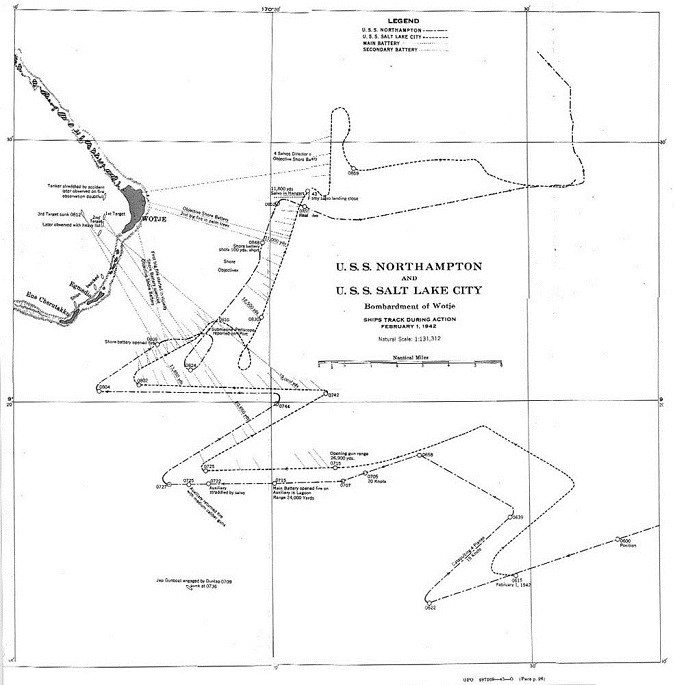
ACTION OF THE YORKTOWN AIR GROUP
The Yorktown, Louisville, and St. Louis made their approach to the attack point between the Marshall and Gilbert Islands on course 270° true, speed 25.5 knots. The support force of four destroyers approached on the same course at a speed of 15 knots. This course was held until 0500 on February 1st and was then reversed. Seventeen minutes later the planes for the Jaluit attack were launched from position latitude 5°01′ N., longitude 171°48′ E., a point 140, 127, and 71 miles respectively from Jaluit, Makin, and Mili. The weather at the time of the launching was high overcast with a large dark bank of clouds and lightning in the direction of Jaluit. The moonlight showing through the clouds was sufficient to give a good horizon for take-off.
Attack on Jaluit Island.
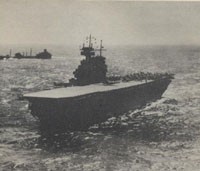
The group consisted of 11 torpedo bombers and 17 scout bombers under the command of Comdr. Curtis S. Smiley, commander of the Yorktown air group. In order to give the scout bombers the maximum radius, it was necessary to use planes without leak-proof fuel tanks. This necessitated some exchange of planes between the scouting and bombing squadrons. The planes were spotted on the flight deck of the Yorktown in order of squadron tactical organization. The first plane in the Jaluit attack group in the spot and to be launched was flown by Lt. Comdr. Robert G. Armstrong. Because of the extremely bad weather the squadron became separated. Since an accurate and complete account of the ensuing events is not available, Lt. Comdr. Armstrong’s experience is presented here as typical:
After making a normal run ahead of about 4 minutes, turning running, tail and formation lights on dim, he executed a wide sweeping turn to the right. A majority of the first division of the bombing squadron joined up in loose formation by the time he had completed the turn passing along the starboard side of the Yorktown on a course parallel. A large group of lights were seen at this time, ahead and to the starboard of the track of the ship. Lt. Comdr. Armstrong then made another easy turn to the right and when again alongside the Yorktown he had with him possibly 15 planes in loose formation which he believed to be the entire bombing squadron attack group. One or two additional easy turns were made on the starboard side of the ship to the right, while
awaiting an opportunity to join up with the torpedo squadron, which should have rendezvoused on the port side of the ship. He believed that during this time some planes from the torpedo squadron joined his squadron.
It was then about 10 minutes past the time for departure and, not having sighted the torpedo squadron, he crossed ahead of the Yorktown and made a wide sweeping turn to the left in hope of making contact. He took his formation well ahead of the port side before turning to a course opposite to that of the Yorktown. Lights were seen which were believed to belong to torpedo bombers. At about 0535, not having been able to complete a rendezvous, he took departure for Jaluit, but 5 minutes later, thinking that he saw lights astern which might have been a part or all of the torpedo squadron, he made a wide sweeping turn to the left in the hope of effecting a rendezvous. On completion of this turn, he again set out for the objective, believing that about 22 or 23 planes were in formation. These included a plane on his starboard bow which he later learned was the Yorktown Air Group Commander.
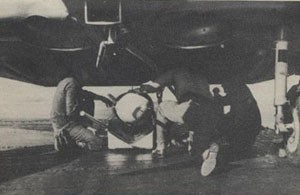
A speed of about 115 knots was maintained in order to conserve the fuel of the torpedo planes with him and those which might be astern, but out of sight. The relatively heavy clouds and the fact that the moon was nearly down made the morning very dark. The horizon was extremely indistinct and it was not possible to avoid or see all of the many thunderstorms in the area. Cruising altitude varied between 400 and 600 feet.
At 0627 Lt. Comdr. Armstrong believed he was near the south tip of Jaluit Atoll. The higher clouds were brightening with the dawn and he decided to climb above the thin overcast in order to avoid detection. He had been using the automatic pilot for about 50 miles, and he now increased the throttle and began to climb at about 300 feet per minute. His plane rose through the thin overcast and plunged immediately into a heavy thunderstorm. Nevertheless he maintained course and climbed for about 2 more minutes through the increasingly heavy rain until he saw two bright flashes which he thought was lightning. He then turned the pilot to descend at about 150 knots, breaking clear of the clouds at 700 feet 3 minutes later. With him were five other planes.
The south tip of Jaluit was sighted about a half mile distant on the starboard bow and a turn to the left away from the land was begun. The planes were then in a clear area about 3 miles wide, dawn having
broken while they were in the thunderstorm. Two large thunderstorms extended in a general northwest-southeast direction for a considerable distance. The leader called on the radio in an attempt to reassemble the group, notifying them he had sighted the south tip of Jaluit, their navigational objective.
He now climbed on a southeast direction for about 7 or 8 minutes. Course was then reversed in order to gain a position over the western part of the atoll, preparatory to commencing the attack. While at about 8,000 feet on this northwest heading, two additional planes were seen flying together about 4,000 feet below. Neither plane heard Lt. Comdr. Armstrong’s call by radio, but they did follow astern while the attack was being made.
High winds, which were much stronger from the northeast than had been anticipated, and the clouds below delayed contact with the westward part of the atoll until 0700. Course was then set for the Jaluit anchorage, the bombing objective. Thunderstorms and heavy clouds covering most of the island caused considerable delay in reaching the anchorage and confusion as to the exact location of the harbor. The harbor was finally found with one large merchant or tender type vessel in the middle of the anchorage. The vessel was ablaze at the stern. Other small vessels of the fishing or patrol type were also anchored in the harbor. A clear picture of the scene could not be obtained because of the clouds.
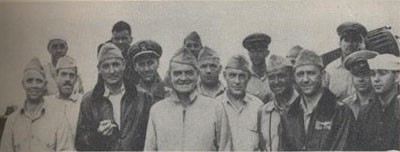
The attack was initiated by the few planes in Lt. Comdr. Armstrong’s section at 0725, diving from about 9,000 feet from south to north. He believes that his bomb missed on the port side of the stern of the vessel by about 100 feet. Complete fogging of the windshield and partial fogging of the telescope developed during the dive.
Recovery from the dive was made at high speed towards Kabbenbock Island, inboard of the channel mouth, with a view to strafing any antiaircraft installations which might be there. Approach was made within 1,000 feet at low altitude without seeing any activity. The course was, therefore, changed towards the tip of Enybor Island, which was supposed to have two landing fields. A clearing at the end of the island held a structure which resembled one of our normal dirigible hangars except it was not more than 200 feet in length. In the southwest part of the clearing, about 200 yards inshore, were four or five structures, that were not over 50 feet square and set on 50-foot stilts. In passing, Lt. Comdr.
Armstrong raked these structures with about 100 rounds of .50-caliber machine-gun fire.
He then continued along the atoll with his section in order to destroy seaplane facilities and aircraft on Emidji. At the seaplane base, three small buildings were encountered, presumably hangars, although much too small to hold four-engine patrol planes. Three small L-shaped breakwaters, projected about 50 yards into the lagoon in front of these buildings, and a number of what appeared to be gun emplacements were observed surrounding the buildings. During a fleeting glimpse of the area, Lt. Comdr. Armstrong saw neither guns, personnel, nor gunfire.
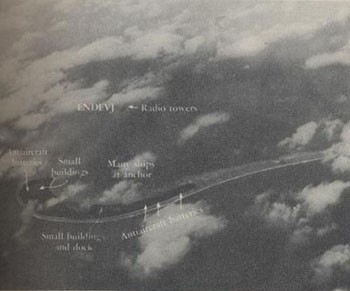
There was a small ship, probably 200 feet long, anchored approximately 500 yards off this seaplane base. About 200 rounds of .50-caliber ammunition was fired at this vessel. During his approach Lt. Comdr. Armstrong observed no activity on the vessel; however, he did see that his tracer bullets were passing through the vessel and richocheting from the water on the far side. His plane was about 50 feet off the water and within 200 feet of the vessel before he pulled up and over.
He continued on up the line of islands at about 100 feet altitude and observed nothing except occasional thatched huts among the palm trees. After passing to the north of Agidyen Island, he turned east, flew through a small rainstorm and circled, calling by radio his wing men to join him. When after about 5 minutes they did not join him, he proceeded southward to a point 10 miles east of the south point of the island and encountered a plane section proceeding towards the ship. He began his return to the Yorktown with his section at about 0740.
Six planes and the crews were lost from our Jaluit attack group, due to the adverse weather conditions encountered both en route to and in returning from the mission. Two planes are known to have been forced down. All planes had to bomb from about 1,000 feet because of the restricted visibility; as a result, they were probably subjected to antiaircraft fire.
The following message was received aboard the Yorktown at 0811 from Lt. Harlan T. Johnson:
“This is 5-T-7. 5-T-7 and 5-T-6 are landing at Jaluit. Are landing alongside one of the northwestern islands of Jaluit. That is all.”
Several of the returning planes landed aboard the carrier with less than 2 gallons of gas remaining in their tanks.
The damage inflicted by our air group at Jaluit was as follows:
- One auxiliary vessel hit by bomb directly on stern and set on fire. This ship stopped immediately and dropped anchor. Later another direct hit was obtained by a torpedo plane dropping a two-bomb salvo. When last observed, the ship was burning fiercely. This vessel was strafed repeatedly.
- One auxiliary vessel suffered at least three near bomb hits and repeated strafing attacks. Only superficial damage can be assumed.
- One auxiliary vessel under way at sea was subjected to one bombing and strafing attack. The bomb missed; damage by strafing considered negligible.
- Other small craft in the harbor were strafed with undetermined results.
- Several bombs were dropped in the administrative building and barracks area near the mole on Jabor Island, causing extensive damage. This area was subjected to heavy strafing by .50-caliber and .30-caliber machine-gun fire.
- At least two bombs were dropped in the vicinity of Enybor Island land-plane facilities and the area strafed. Damage undetermined.
- The buildings indicated as seaplane facilities on Emidji Island were strafed. Damage undetermined.
Attack on Makin Island.
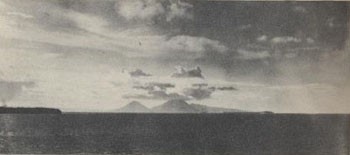
The launching of the Makin attack group was completed at 0544 at latitude 5°00′ N., longitude 171°57′ E. The group consisted of nine scout bombers, each plane armed with one 500-pound bomb. The island of Makin was sighted at 0630, under a large rain squall. The group, at this time, was flying at an altitude of 1,000 feet. Course was reversed and an altitude of 12,000 feet was gained before the group closed in on the island. Anchored in the harbor were one seaplane tender of about 8,000 tons and two 4-engined seaplanes. It was decided to attack the seaplane tender with all nine 500-pound bombs and then strafe the seaplanes. At 0658 the dive-bombing attack was made and it is believed that two direct hits were scored on the tender and all the other bombs fell within 100 feet. Seven minutes later the two 4-motored seaplanes
were set on fire and the remaining fixed ammunition expended on the tender. A few Japanese were hit in the forward part of the ship during the strafing attack. The tender returned some fire with a small caliber antiaircraft gun.
The only other item of military interest on Makin was a small barge tied up to the government pier. No shore batteries, antiaircraft or gun emplacements were observed.
At 0730 the squadron was rendezvoused and proceeded to the Yorktown, landing aboard at 0815.
One of the Makin planes made a forced landing in the water while circling the carrier during a severe storm. Personnel were recovered by one of the supporting destroyers.
Attack on Mili Atoll.
The five scout bombers composing the Mili attack group were launched at 0604 from position latitude 5°01′ N., longitude 172°06′ E., and picked up Mili Atoll 30 minutes later when at an altitude of 2,000 feet. The group then climbed to 12,000 feet, taking cover in a bank of clouds along the eastern edge of the Atoll. Absolutely no military targets were visible from this altitude so the group went down to reconnoiter and found only a large barn-shaped structure, probably a storehouse on the island west of Tokawa Island. A section of three planes were ordered to attack the storehouse at 0720 and the second section of two planes to withhold attack until a better target could be found. Due to the low ceiling no bomb hits were seen on the warehouse. After reconnoitering the western area of the atoll, the second section attacked another small warehouse and a storage tank (probably for water). The group rendezvoused over Knox Island and took departure for the Yorktown at 0810, landing aboard about 35 minutes later.
* * *
The cruiser Louisville lost one of her reconnaissance planes during the operation. This plane was launched at 0642 to act as an antisubmarine patrol within 5 miles of the carrier. At 1226 the Louisville began recalling the plane by radio, but received no reply.
* * *
The attack by Task Force FOX was apparently a complete surprise to the Japanese. No enemy surface units were encountered by the ships of this force. However, a four-engine patrol bomber attacked the sup-
porting destroyers. These had been sent astern with the hope of recovering planes from the Jaluit raid which were overdue. Later another, or possibly the same bomber was shot down by the fighter combat patrol close to the Yorktown.
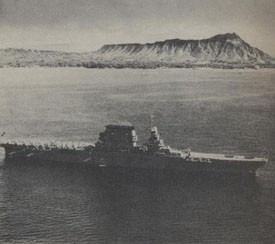
This bomber was sighted coming out of low clouds at approximately 1,000 feet altitude. The plane, which was of the Kawanishi (French Potez) type, maintained a distance of about 15,000 yards from the carrier. Fire from the Yorktown was withheld in order not to interfere with our fighters making an attack. Presently, the enemy disappeared behind a cloud and two of our fighter planes were seen to follow him. Less than 4 minutes later the enemy plane fell out of the clouds and burned, giving off dense black smoke for about 5 minutes after striking the water. It is believed possible that this bomber was equipped with radar in view of his ability to locate our force in spite of the poor visibility.
It had been intended to return to make another raid on Jaluit the same afternoon. However, the planes were so badly overdue returning that a second raid probably would have necessitated night recovery in the heavy rainstorm then prevailing. The second attack was abandoned.
Later orders were received from Admiral Halsey directing this force to withdraw not later than the ensuing night. The ships then set out for Pearl Harbor, arriving on the 6th of February. Admiral Halsey had entered the day before.
* * *
CONCLUSION
Following this action Admiral Nimitz wrote the following letter to the Secretary of the Navy:
| From: | Commander In Chief, United States Pacific Fleet. | |
| To: | The Secretary of the Navy. | |
| Subject: | Report of action, Marshall-Gilbert Islands raids, by Task Forces “HOW” and “FOX”. |
- The action in the Marshall-Gilbert Islands raids by our forces is considered to have been well conceived, well planned and brilliantly executed. It is noted that heavy rain interfered with the attack on Jaluit.
- The results obtained by both raids were the more noteworthy as the task forces were obliged to make their attack somewhat blindly due to lack of information. The little information that had been obtained was made available as a result of observations by our own submarines. This information, although fairly accurate
as to shipping, was rather meager regarding fortifications, aviation facilities and other defensive installations.
- An analysis of the gunnery performances was made after the return of the task forces. The actions against the land and surface objectives were generally excellent. The antiaircraft batteries did not provide satisfactory results. The causes of the poor performance of the antiaircraft battery were masked to some extent by the Mark 18 Mod. 0 and Mod. 1 fuzes. Other causes that contributed were: failure of information to reach battery personnel through faults within the ships, lack of fire discipline under diversified attack, and minor personnel errors associated with inexperience under fire. With the exception of the Mark 18 Mod. 0 and 1 mechanical time fuze and three apparently premature explosions of the Mark 13 MCBD fuze, the material stood the test most satisfactorily. Corrective measures have been instituted for all gunnery faults and failures determined.
- Our own losses were small considering the magnitude of the operations. For their excellent performance and execution of their mission, Vice Admiral Halsey was recommended for and awarded, by the President, the Distinguished Service Medal; and Comdr. Miles Browning, his Chief of Staff, was promoted to the temporary rank of captain. Commendations for other personnel participating in the raid and operations connected therewith are being handled in separate correspondence.
s/ C. W. NIMITZ.
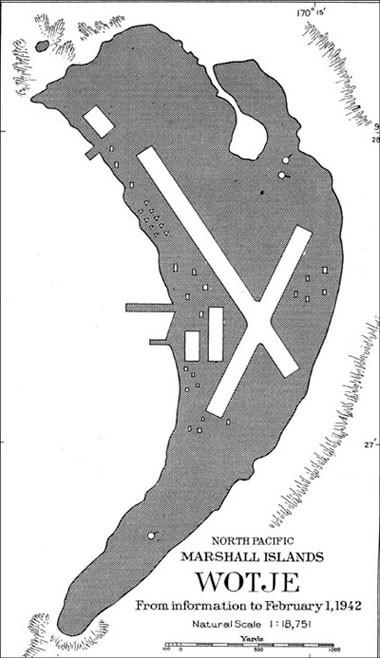
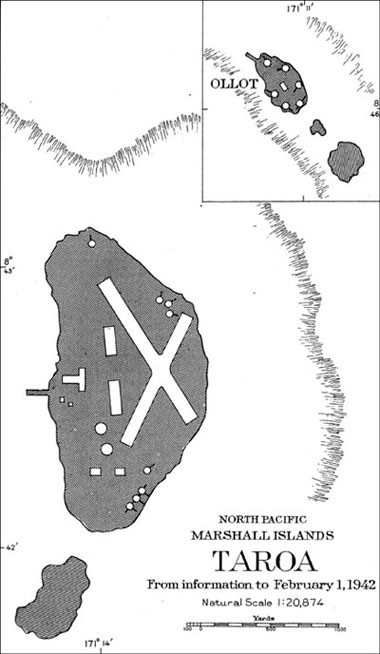
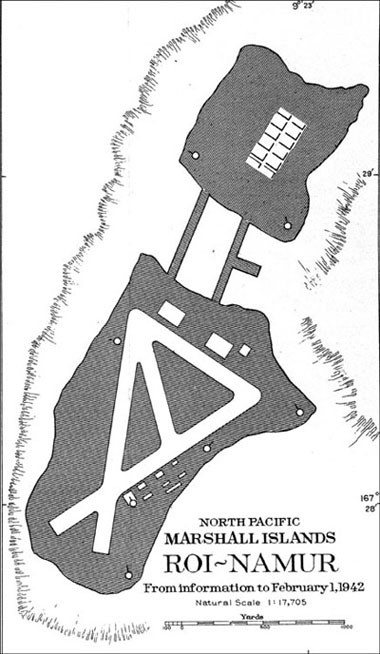
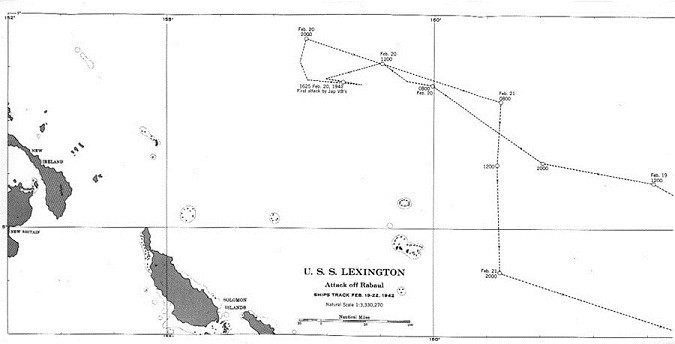
Action Off Rabaul
February 20th
HAVING carried out the attacks on the Marshall and Gilbert Islands, the two task forces commanded by Vice Admiral Halsey, were retiring to the eastward on the 1st of February 1942. Admiral Halsey had burned excessive fuel in making his retirement under enemy bombing attacks, and deemed it necessary to request the Commander in Chief, United States Pacific Fleet, that arrangements for an emergency fueling rendezvous be made. It so happened that at that time Task Force BAKER, commanded by Vice Admiral Wilson Brown, U.S.N., had recently left Pearl Harbor and was proceeding southward on a patrol mission. Accordingly, CINCPAC directed Admiral Brown to divert course toward the Marshalls in order to cover the withdrawal of Admiral Halsey’s ships and provide fuel as necessary.
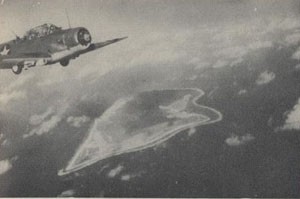
As it turned out, Admiral Halsey’s forces were able to return to base without the emergency refueling. In the meantime, however, Task Force BAKER had received further orders. These orders were the outgrowth of a dispatch from COMINCH to CINCPAC which contained the information that a widespread, coordinated Japanese offensive was expected, possibly involving strong attacks on Midway, Oahu, the New Hebrides, northeast Australia, the Canal Zone or United States West Coast. CINCPAC was ordered to dispose his forces so as to hit the enemy wherever and whenever he might attack. A second COMINCH dispatch called attention to an anticipated enemy offensive in the direction of New Caledonia, the New Hebrides or other positions on our lines of communication with the southwest Pacific. It appeared that the Japanese would gather their forces at Rabaul, New Britain, preliminary to launching an offensive. The dispatch specified that Task Force BAKER, augmented by additional cruisers and destroyers as well as Navy patrol planes and Army bombers from other areas, should proceed to the southwest Pacific and operate under the Commander ANZAC Forces, Vice Admiral Herbert F. Leary in such a manner as seemed
advisable to COMANZAC. At that stage of the Pacific war, Allied convoying, garrisoning and other activities necessary to the defense of the south Pacific were in an embryonic and vulnerable phase.
PLAN OF ATTACK
After taking up his station with Task Force BAKER, Admiral Brown conceived a plan for an attack on Rabaul and received authority from COMANZAC to carry it out. Roughly speaking, the plan called for an air and surface attack on the enemy base, to be coordinated with an attack by United States Army heavy bombers of the Australian command, at dawn on February 21st. Combatant ships at Admiral Brown’s disposal were:
One carrier –
Lexington (flagship of Admiral Brown), Capt. Frederick C. Sherman.
Four heavy cruisers –
Minneapolis, Capt. Frank J. Lowry.
Indianapolis, Capt. Edward W. Hanson.
Pensacola, Capt. Frank L. Lowe.
San Francisco, Capt. Daniel J. Callaghan.
Ten destroyers –
Phelps, Lt. Comdr. Edward L. Beck.
Dewey, Lt. Comdr. Charles F. Chillingworth, Jr.
MacDonough, Lt. Comdr. John M. McIsaac.
Hull, Lt. Comdr. Richard F. Stout.
Aylwin, Lt. Comdr. Rohert H. Rogers.
Dale, Lt. Comdr. Anthony L. Rorschach.
Bagley, Lt. Comdr. George A. Sinclair.
Patterson, Comdr. Frank R. Walker.
Clark, Comdr. Myron T. Richardson.
Drayton, Lt. Comdr. Laurence A. Abercrombie.
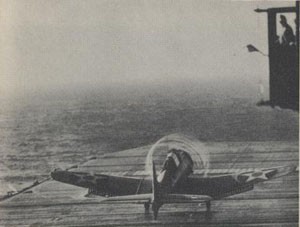
Moist air on the morning of February 24 produced this curious effect around the propellers of our planes
The plan of attack was elastic, in that it contained a proviso that the surface bombardment was to be made only if the air attack was a success. The Pensacola, Clark, and Bagley were designated as this provisional attack group.
The approach on Rabaul was made from due east, the intention being to place the Lexington in a position to launch her planes at a distance of 125 miles from the objective at 0400 of the 21st. On the morning of the 20th, Task Force BAKER was some 350 miles northeast of Rabaul. Enemy patrol flying boats were encountered, and these planes no doubt reported the presence of our force. At any rate, Task Force BAKER was attacked several hours later by enemy heavy bombers. A highly successful action ensued, which is described below. However, the element of surprise had been lost. Furthermore, it became evident that as a result of their high speed maneuvering during the enemy attack our ships no longer had sufficient fuel to safely carry out their mission. It seems the estimated fuel consumption had been based on a slow approach. Admiral Brown, after steering a course directly toward Rabaul for the remaining daylight hours in order to create as much alarm among the enemy as possible, ordered a withdrawal. His decision was approved by both CINCPAC and COMINCH, as evidenced by reports and congratulatory messages.
THE ACTION
At 1015 on the 20th the Lexington radar picked up an unknown aircraft 35 miles from the ship on bearing 180° true. A six-plane combat patrol was launched, two fighters being directed to investigate the contact. These two planes, under command of Lt. Comdr. John S. Thach located a Japanese four-engined flying boat about 43 miles out and shot it down at 1112. Later another radar contact 35 miles ahead was made and two other planes of the combat patrol, commanded by Lt. (j.g.) Onia B. Stanley were sent to the contact point. They discovered a second enemy four-engined flying boat and shot it down at 1202. A third contact was made 80 miles ahead, but the enemy soon reversed course and disappeared. At 1326 a relief combat patrol and an afternoon search group were launched and the first group of planes were landed.
The Lexington was steaming at 20 knots on a course 234° true at 1542 when her radar indicated a large group of planes approaching from the direction of Rabaul and about 76 miles distant from the ship. At 1615 a relief patrol of six fighters was launched and the previous patrol was told to land. However, 5 minutes later radar showed the enemy planes to be close to the carrier, and both patrols were ordered to intercept. Vectored out by radar and the Lexington‘s fighter director, our planes made contact well out with nine Japanese twin-engined bombers at an altitude of 11,000 feet. The enemy aircraft appeared to be a modified type 97. They approached from the starboard side swinging astern to make their runs. Our fighters attacked and shot down five of them before they reached the bomb release point. Our planes broke off the attack in the face of our ships’ antiaircraft fire. In the case of the Lexington, fire was opened by the starboard 5-inch guns at a range of 10,000 yards. These guns were credited with damaging the leading plane of the enemy formation, which approached in a shallow “V of V‘s”.
As is often the case, there was some doubt as to just what caused the destruction of planes – fighters or antiaircraft fire. However, of the four enemy aircraft which reached the point of release, only one escaped. Moreover, the bomb salvo fell a full 3,000 yards short of the Lexington, the intended target, and it is reasonable to assume that this wildness was a result of the effective joint defense put up by Lexington fighters and the antiaircraft fire of the task force.
As near as can be determined from available information, three of the four enemy planes which were able to release their bombs immediately fled. Our fighters again attacked as soon as the ships ceased firing, and caught and shot down two of the three. The third escaped in good shape. In the meantime, the fourth enemy bomber had peeled off and begun a low-level strafing attack on the Lexington.
The behavior of this plane, and that of another which will be detailed below, caused some of the people in Task Force BAKER to conclude that it was doctrine for damaged Japanese planes to attempt to crash aboard our ships. The plane came in against the Lexington from the starboard beam. Fire was opened by all starboard 1.1 and .50-caliber mounts at 2,500 yards. The enemy was smoking by the time he had come within 1,000 yards of the ship, and the smoke increased until he crashed in flames 75 yards astern.
During the course of this attack, the Lexington launched 4 fighters and 11 patrol planes and landed 5 fighters for reservicing, all while maneuvering with 30° rudder at 30 knots to avoid bombs.
Meanwhile, a second group of nine enemy planes was detected by radar approaching from eastward. All Lexington fighters in the air except two were pursuing the remnants of the first wave of enemy planes and were not in a position to intercept. As the enemy came up on the starboard quarter, the two available fighters, led by Lt. Edward H. O’Hare, attacked. The guns of one fighter immediately jammed. Lieutenant O’Hare continued to attack alone. He shot down two bombers almost at once and damaged three others, so that only four of the enemy reached the release point. The Lexington maneuvered radically, and the salvo fell astern, the nearest splash being 100 feet away.
Lieutenant O’Hare, meanwhile, persisted in his attacks and shot down two more bombers in flames and caused a third to crash into the sea. He thus was directly responsible for the destruction of five enemy planes. In the opinion of Admiral Brown and of Capt. Frederick Sherman, commanding the Lexington, Lieutenant O’Hare’s skill and daring may have saved the carrier from serious damage or even loss.
Of the four planes of the second wave of nine which managed to release their bombs, one was shot down 8 miles ahead by a fighter, a second 40 miles ahead by a fighter, a third 80 miles ahead by returning scout bomber, and the fourth was badly damaged but still flying after a 150-mile running fight with the aforementioned scout bomber. The pilot of this SBD, Lt. Edward H. Allen, and his free gunner, Bruce Rountree, radioman first class, were highly praised by their superiors for their achievement with a plane not intended for that type of work. They broke off their attack on the enemy only because of fuel shortage.
Good flying conditions held throughout the action. Various cloud formations were present at altitudes ranging from 2,800 to 25,000 feet, but these, particularly the low ones, were broken by large clearings. Visibility was from 15 to 20 miles. A slight sea was running.
During the second attack, the Lexington‘s starboard 5-inch guns opened fire and continued until the swinging of the ship to port operated the cut-out cams. Fire was opened by the port batteries as they bore. A total of 133 rounds were fired in all. No hits were claimed. Gunners complained of not being able to distinguish their bursts from those of escorting ships. At one point an enemy bomber approached the Lexington from the port side on a 30° converging course, giving the appearance of trying to strafe the ship or crash aboard. One 1.1 mount and two .50-caliber guns opened fire at 3,000 yards range. The enemy plane crashed in flames about 1,500 yards off the port bow. As far as can be determined, this plane was one of the 5 put out of the bombing action by Lieutenant O’Hare.
Antiaircraft fire by ships in the rear of the formation was heavy but inaccurate. Our pilots reported that bursts were beyond the target by 500 to 1,000 feet on the first attack and short by more than 1,000 feet on the second. Illustrative of the conflicting opinions as to the effectiveness of our antiaircraft fire was the fact that our fighter pilots stated positively that no enemy planes were shot down, while observers on ships’ decks report from two to four. Fighter pilots also complained that the anti-aircraft fire hampered them in driving home their attacks on enemy aircraft approaching the bomb release point. Four of our fighters engaged in the action were slightly damaged by our own antiaircraft fire, one pilot sustaining superficial wounds.
By 1900 all Lexington planes had been landed except for two fighters which were shot down while attacking enemy bombers. It is of interest to note that both planes were lost while making steady, no-deflection runs from astern of their targets. The pilot of one fighter was picked up after parachuting to safety. The other, Ensign John Woodrow Wilson, sank with his plane.
Summary of results.
Enemy losses:
- Two four-engined patrol planes shot down.
- Sixteen of 18 two-engined bombers shot down; 1 damaged and probably lost; 1 escaped.
Our losses:
- Two fighter planes; one pilot saved.
CONCLUSION
The action of February 20 tended to show that an aircraft carrier can defend itself against a bombing attack, provided the enemy planes have no fighter support, the attack is not coordinated with one by torpedo planes, and the number of planes is limited. The Lexington was very nearly caught by the second wave of enemy bombers, evading their missiles by what appeared to be a combination of skillful maneuvering and good luck. “It is my considered opinion,” Admiral Brown reported, “that if we had been attacked by 40 planes instead of 18, only a miracle could have prevented damage to the Lexington.”
Our antiaircraft fire was poor, even though the enemy planes came on in tight formations, holding a steady course and altitude throughout most of the 6 miles of their approach which was observed by our ships.
The Japanese two-engined bombers showed a gratifying vulnerability, particularly to being set afire in the engine sections.
The Raids on Wake and Marcus Islands
February 24th and March 4th
DESPITE the tactical success of the preceding attacks on enemy bases, the Japanese flood of military, naval, and air power continued to pour into British and Dutch possessions in the southwestern Pacific. During the first week of February enemy forces, having overrun Malaya, were approaching Singapore, and were filtering down through Borneo, Celebes, New Guinea, and the Solomons in the direction of Sumatra, Java, and Australia. Because the available strength of the United Nations in this area was so sparse that little more than delaying action could be realistically considered, another diversion in the northern or mid-Pacific seemed advisable to the American naval command. At the least, such an enterprise would increase our security at Midway and at other points in the central and southern Pacific. At the most, by striking in the direction of Japan’s homeland, it might disturb the Japanese strategists sufficiently to cause them to halt their far-extended advances in the southwest.
PLAN OF ATTACK
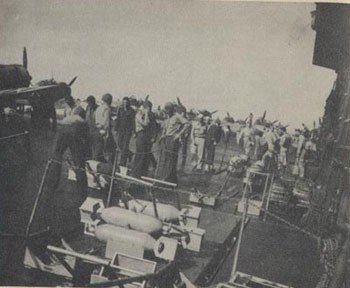
Flight deck of the Enterprise
On February 11th organization orders were issued for Task Force HOW. This force was directed to raid Wake Island, which had been under enemy control since December 22d, and Eniwetok Island in the northern Marshalls. It was from this latter island that the Japanese had presumably launched their bombers against Wake. The expedition’s announced objectives were: (1) to weaken the enemy and gain information as to his dispositions; (2) to divert enemy strength from his offensives in the southwest; (3) to cover our positions and communications in the mid-Pacific. If, however, important enemy combatant forces were encountered within striking distance, these forces would become the primary objective.
Mention was made that another task force, recently reinforced, was to operate in the Fiji-New Caledonia area, and was to cooperate with the ANZAC forces in taking offensive action against enemy forces which might advance into that area. Friendly submarines would be clear of Wake and Eniwetok by the time Task Force HOW approached those islands. Much information regarding Wake was provided, and was later amplified by new photographs taken by an Army plane. These were developed and printed in Oahu, and then flown to Task Force HOW at sea by a PBY. Information regarding Eniwetok and Marcus, a Japanese island northwest of Wake which might in the task force commander’s judgment be substituted for Eniwetok as object for attack, was necessarily meagre.
For the purpose of the raids, Task Force HOW was divided into two groups, the first being commanded by the Task Force Commander, Vice Admiral William F. Halsey, Jr., and the second by Rear Admiral Frank J. Fletcher.
The first group consisted of:
One carrier,
Enterprise, Capt. George D. Murray.
Two cruisers,
Northampton, Capt. William D. Chandler;
Salt Lake City, Capt. Ellis M. Zacharias;
Rear Admiral Raymond A. Spruance, commander of Cruiser Division FIVE, in Northampton, commanding.
Seven destroyers,
Balch, Commander Charles I. Rend;
Dunlap, Lt. Comdr. Virginius R. Roane;
Maury, Lt. Comdr. Elmer D. Snare;
Craven, Lt. Comdr. Allen P. Calvert;
McCall, Commander Frederick Moosbrugger;
Ralph Talbot, Commander Ralph Earle, Jr.;
Blue, Commander Harold N. Williams;
Capt. Richard L. Conolly, commander of Destroyer Squadron SIX, in Balch, commanding.
Oiler,
Sabine, Commander Hugh L. Maples.
The second consisted of:
One carrier, Yorktown, Capt. Elliott Buckmaster.
Two cruisers,
Astoria, Capt. Francis W. Scanland;
Louisville, Capt. Elliott B. Nixon;
Rear Admiral William W. Smith, in Astoria, commanding.
Six destroyers,
Anderson, Lt. Comdr. John K. B. Ginder;
Hammann, Commander Arnold E. True;
Hughes, Lt. Comdr. Donald J. Ramsey;
Sims, Lt. Comdr. Willford M. Hyman;
Walke, Lt. Comdr. Thomas E. Fraser;
Russell, Lt. Comdr. Glenn R. Hartwig;
Capt. Charles P. Cecil, commander of Destroyer Squadron THREE, in Anderson, commanding.
Oiler,
Guadalupe, Commander Harry R. Thurber.
The first group was directed to attack Eniwetok 10 minutes before sunrise February 24th, while the second group simultaneously pounded Wake. Attack on both bases was to be with aircraft and ship bombardment at the discretion of the task force commander. The commander, moreover, was informed that if discovery or other development made attack on Eniwetok inadvisable, he might substitute another target, including Marcus.
Priority of objectives was listed as (1) combatant ships; (2) aircraft, particularly those on ground or water; (3) other ships; (4) aircraft supporting installations, fuel tanks, power and radio installations; (5) troop concentrations and fortifications; (6) storehouses. The groups were specifically ordered to seize any opportunity to destroy important enemy forces. Photographs were to be made if possible, but not to such an extent as to impair the scale of attack. Any fishing boats or other small craft encountered west of longitude 170° were to be regarded as enemy and sunk as quickly as possible. Aircraft were instructed to avoid being sighted by such boats or being observed from islands.
The first group of Task Force HOW left Pearl Harbor, February 14th, in accordance with orders, and the second group followed 2 days later. Proceeding westward toward the attack areas, both groups engaged in target practice and other exercises. Meanwhile the situation in the Pacific southwest had deteriorated even further. Singapore fell to the enemy February 15th, and there now seemed no likelihood of halting his advance short of Australia.
According to an unofficial report, aircraft were vitally needed at this time to guard a large commercial ship which had put in at Palmyra Island, south of Hawaii. At any rate, on February 16th, Admiral Halsey received orders from CINCPAC that the second group of Task Force HOW had been detached and had been redesignated Task Force FOX. This latter force was instructed to proceed to the area of Canton Island in the Phoenix group. The first group of Task Force HOW was ordered to execute the attack on Wake, ignoring Eniwetok.
SHIP BOMBARDMENT OF WAKE ISLAND
The operation order issued February 21st by Admiral Halsey provided only for an aircraft assault on Wake. On the following day, however, he directed the two cruisers, the Northampton and Salt Lake City, and the destroyer leader, Balch, with a second destroyer, the Maury, to bombard Peale (a small island adjoining Wake) and the north end of Wake at the same time the Enterprise‘s air group was bombing the air field at Wake and the nearby island of Wilkes. In order to increase the chances of surprise, he suggested that the cruisers and their destroyer escort approach Wake from the west. The bombardment was to be synchronized with the air attack; that is, both were to begin 10 minutes before sunrise.
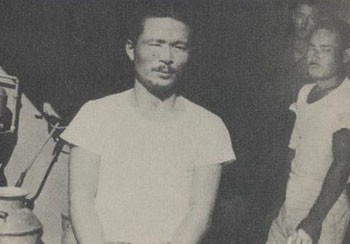
The bombardment group remained with the rest of the task force until late in the afternoon of February 23d when it broke off and began working its way to the westward. No contact was made with the enemy during the night, but at 0505 (all times hereafter cited are Zone Minus 12) an RDF bearing was obtained of a Japanese voice transmission which may possibly have been from a patrol craft reporting the presence of our ships. At that time the bearing of Wake was 157°, distant 37 miles.
In accord with plans, the bombardment group continued to proceed southwest in column, the order of ships being Maury, Northampton, Salt Lake City, and Balch, distance 1,500 yards. At 0641 the column assumed a course of 090°, speed 21.2 knots, and thereafter during the bombardment it pursued a generally easterly or northeasterly course, with Wake and its two satellite islands to starboard. The cruisers refrained from launching their planes until the last minute lest the flash of the catapulting might be seen from the shore and thus compromise the surprise of the Enterprise‘s planes which were scheduled to arrive over the islands at 0708 (10 minutes before sunrise). As a matter of fact, this proved a needless precaution, as bad weather delayed the launching of the Enterprise air group fully a half an hour. Indeed, 3 Japanese seaplanes were the first to be sighted at 0707. These were of the 95 reconnaissance or Kawanishi type. They subsequently dive-bombed the Maury and Northampton, but their bombs fell wide and did no damage. At that time the ships were about 18 miles from Wake.
Between 0710 and 0722 the Northampton launched four planes and the Salt Lake City two for reconnaissance and spotting purposes, and at
0742, when the range of Peale Island had fallen to 16,000 yards, the column opened the bombardment. The bearing of the island at this time was 115° true. Although the weather was good, a heavy mist covered the islands and it was difficult to see the target, especially since the approach was from the west and the rising sun shone in the eyes of the director pointers, trainers, and range-finder operators. Throughout the bombardment our ships maintained a range of between 14,000 and 16,000 yards. This was at the outer range limit of the shore batteries, as shells from their guns landed at times within 100 yards of the ships. The Maury, leading ship, usually kept 1,000 to 1,500 yards inside of the cruisers.
The bombardment lasted about half an hour, the Northampton ceasing fire, her allowance of main battery ammunition having been expended at 0808, and the three other ships a few minutes later. Peale Island was subjected to extremely heavy fire, and many of the buildings and installations suffered damage. One structure, apparently a gasoline storage, burst into flames, which shot hundreds of feet into the air. Numerous smaller fires were seen. A large dredge in the lagoon near the seaplane ramp was hit and set on fire. Shore batteries, however, along the northern shores of Peale and Wake Islands were not completely silenced.
In the bombardment the Northampton expended 264 rounds of 8-inch common and the Salt Lake City 261 rounds at ranges of from 14,000 to 16,000 yards. The Balch used 995 rounds of 5-inch common and 199 rounds of antiaircraft common at shore objectives varying from 13,700 yards to 16,000 yards. The Maury, the guide ship, expended only about 348 rounds of 5-inch antiaircraft common at shore objectives at ranges of from 8,000 to 12,000 yards. The Maury‘s expenditure at shore objectives was materially reduced by the necessity of alerting gun battery for and firing at the enemy scout seaplanes which attacked the ship bombardment group.
In the action reports there are distinct differences of opinion as to the effectiveness of the bombardment. One officer states: “Shore batteries present poor targets, and firing at them with cruiser 8-inch is in general considered wasteful of ammunition for the results obtained.” Another remarks: “When available, bombardment ammunition should be provided for these operations. With limited expenditures necessitated by use of armor-piercing projectiles, excellent objectives usually appear late in the bombardment. In this case, an excellent enfilade was afforded
on the eastern end of Wake Island which could not be utilized.” The destroyers’ officers, however, appeared satisfied with the result of their gunfire, one writing, “5-inch gun fire was again apparently effective in silencing shore batteries of the character installed in these islands.”
No damage or casualties were suffered during the exchange of gunfire, but at 0828 the Northampton‘s radar went out of commission because of the collapsing of the antenna array from the shock of the ship’s own guns.
Following the bombardment the planes attached to the cruisers were directed to bomb the islands. Previously they had rendezvoused and climbed to a spotting station about 5,000 feet up and north of Peale and Wake Islands. At 0830, in accord with orders, they delivered a dive-bombing attack on buildings located on the northwest tip of Wake, dropping eleven 100-pound bombs. “Dropping our little, puny bombs with our obsolete aircraft was more a gesture than anything else,” one of the participating pilots has since remarked. During the course of this attack the SOC’s were themselves attacked by a Japanese seaplane of the same type. Although the enemy plane was, by all accounts, superior to ours both in power and speed and made six attacks, the cruiser planes escaped undamaged.
Meanwhile the ships were proceeding to a rendezvous point about 20 miles northeast of Wake. On the way, at 0845, the Maury opened fire on a Japanese patrol boat of about 175 tons. Planes from the Enterprise had previously been seen bombing the craft. The Maury quickly sank the boat with shots from guns 2 and 3 at 3,000 yards range. While attention of her officers and men was concentrated on the possibility of rescuing survivors, an enemy seaplane made a surprise bombing attack, dropping two bombs 50 yards on the Maury‘s port beam without being taken under fire. The Maury immediately abandoned any idea of rescuing the Japanese. Between 0919 and 0947 the Northampton and Salt Lake City recovered their six SOC planes, and the column set a course of 040°, speed 25 knots. No casualties were suffered by the air personnel.
As the ships retired to the eastward, an enemy patrol plane was seen to be following them persistently, although always remaining beyond gun range. This plane “shadowed” the group until sunset.
At 1054 an enemy patrol boat of about 400 tons was sighted on bearing 006°, distant 6 miles. The Balch was ordered to sink it, and did so with gunfire in a few minutes. Shortly after the enemy craft sank, an
underwater explosion was heard, believed to have been made by depth charges aboard which had not been set on “safe.” At half past 11 the Balch picked up four Japanese survivors, three of whom had superficial cuts. All men were searched, given medical treatment, and placed under guard as prisoners of war.
The rest of the day was uneventful except for the frequent sighting of the “shadowing” enemy plane, which called for constant manning of the antiaircraft guns. A request was radioed to the Enterprise for fighter planes to drive the shadower away, but, as will be related in another place, the Enterprise‘s planes failed to locate either the ship group or the snooper. At 1743, when it was becoming dark, this patrol plane, or another like it, was seen to be approaching somewhat nearer. All attention was centered on this threat at 6 o’clock when, much higher and from another part of the sky, two twin-engined landplanes appeared and almost immediately released their bombs from an altitude of 13,000 feet before effective antiaircraft fire could be developed. The bombing was accurate, three bombs landing near the Salt Lake City, and one near the Northampton. No damage, however, resulted, and all three planes then disappeared.
In regard to this incident Admiral Spruance, commanding the bombardment group of Task Force HOW, has written: “At the time of the attack cruisers were in line of bearing approximately normal to the sun, to best cope with an attack from that direction. It is interesting to note, however, that in this case the planes made their approach along the line of bearing, in which direction the least effective antiaircraft fire could be developed. The fact that the sun was low (45 minutes before sunset) may have convinced the enemy of the advantages of approach from a direction where least concentration of fire might be expected, rather than from the direction of the sun. Also, both cruisers could be bombed on the same run. The inoperative status of Northampton radar was sorely felt at this time. The approach of these planes undetected may have been caused by too much attention being concentrated on the tracking patrol plane, which was in plain sight. This emphasizes the serious consequence of lookouts and others being distracted from their assigned sectors by such a diversion.”
On this same point Captain Zacharias, commanding officer of the Salt Lake City, wrote: “The carrier fighter planes left the scene before all enemy planes (particularly four-engined patrol planes) had been
destroyed. This left the heavy ships vulnerable to shadowing and later bombing, which should have been prevented. It is, therefore, recommended that the carrier be sufficiently close to the heavy ships to send fighters to destroy shadowers when notified of their existence. It is noted that as a result of this shadowing, in addition to the bombing attack made near dark, the persistence of the enemy enabled them to fix the position at dark and provide for a systematic search from that point the next day. The radius of search was just short of finding us. There appears to be a special technique used by the shadower after his bombing planes have arrived in the area. In this case, the shadower, after remaining on the horizon all day and at times invisible, suddenly started an approach as if to attack. This had the effect of centering attention on himself. Meanwhile the bombers at very high altitude approached the release point unobserved until just as they were about to release. Observed at this time proper avoiding action was taken and heavy bombs fell where the ship would have been. It is therefore recommended that in the presence of a shadower a special overhead ‘release point’ lookout be established in a reclining chair on the bridge, particularly when cloud formations exist as in this case.
At 0730 the following morning the ships rejoined the remainder of Task Force HOW at rendezvous. No damage or casualties had resulted from enemy action. The Maury reported one 5-inch gun not usable after the firing, and the two Salt Lake City planes left on board were damaged somewhat by shock of ship’s own gunfire. All commanding officers and executive officers reported conduct of personnel as having been excellent throughout the engagement, efficiency and confidence having been increased by exposure to fire in earlier encounters with the enemy. The Salt Lake City maintained, with good effect, its procedure of keeping personnel below decks informed of progress of the action by means of the loudspeaker.
AIR BOMBING OF WAKE ISLAND
Late in the afternoon of February 23d the carrier Enterprise, with Admiral Halsey commanding Task Force HOW, left the bombardment group and steamed southward toward Wake. The Enterprise was accompanied by four destroyers, the Dunlap, Blue, Ralph Talbot, and Craven. At 0420 her position was latitude 21°6′ N., longitude 166°16′ E.; and a few minutes later she changed her course to 135°. At 0517, when the Enterprise was 120 miles north of the island, she headed into the easterly wind at a speed of 25 knots and began launching her planes.
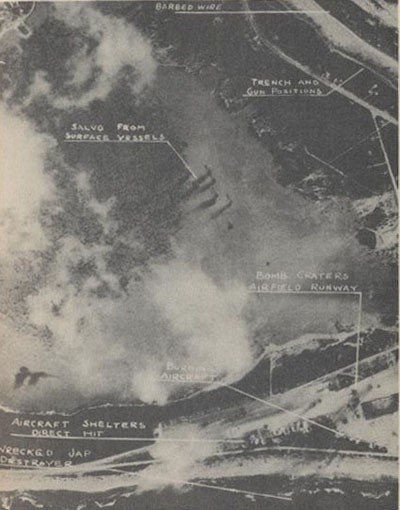
Darkness, rain and a solid overcast shrouded the flight deck. Rich mixtures in the engines, necessitated by conditions, produced in the damp atmosphere a halo effect on the propeller wash which confused some of the pilots.
During the take-off one of the pilots, an experienced flier, rolled off the port bow. His plane was lost, although he himself was rescued, badly injured. The plane guard destroyer failed, however, to find his radioman-gunner, E. P. Jinks, radioman, third class. The bad weather also rendered it difficult for the planes to rendezvous, so that the attack group was unable to take departure until 0650, or 30 minutes later than planned. Additional time was consumed by planes which could not find their proper attack positions until daybreak.
The attack group consisted of the air group commander, Commander Howard L. Young, 18 bombers (SBD’s), 18 scout bombers (SBD’s), 9 torpedo planes (TBD’s) and 6 fighters (F4F’s). The bombers and scout bombers were each armed with one 500-pound and two 100-pound bombs (instantaneous fuses). The torpedo planes carried twelve 100-pound bombs each. After these planes were in the air, a combat patrol of 4 fighters was sent up to guard the Enterprise.
Fortunately, as the attack force approached the island, the weather improved with scattered clouds between 3,000 and 5,000 feet affording partial concealment. A surface wind was blowing from the east at 24 knots.
With the bombers and fighters climbing to altitudes varying from 14,000 to 18,000 feet and the torpedo planes to 12,000, the group arrived at the target shortly before 8 o’clock. The bombardment group was then completing its shelling of installations on Peale and the northern part of Wake. Because of this, the air group commander ordered the attack expedited. Within 4 or 5 minutes the bomber squadrons began dive-bombing the airfield and nearby installations, while the torpedo planes commenced horizontal bombing. As no air opposition was encountered, the torpedo planes made independent section attacks.
Failing to find aircraft on or near the field, the dive bombers concentrated on damaging the runway, underground shelters, magazines and other scattered targets indicated on the charts. About half of the scout bombers dropped their three bombs in ripple salvo. The others dropped
their 500-pound bombs in their initial attack; then made a second, and in some cases a third, attack with 100-pound bombs, dive bombing or glide bombing. High speed run-ins were started from 18,000 feet 20 miles out with the final dive being entered between 8,000 and 12,000 feet. The first division of Bombing Squadron SIX attacked the air field from the west and was followed by all of Scouting Squadron SIX. Immediately afterwards the second and third divisions of Bombing Squadron SIX came in from the southeast and east respectively.
A section of the torpedo squadron was joined by the air group commander and the photographic section for a composite bombing run on the gasoline stowage at the southwest end of Wake. Another torpedo section made its first run on an antiaircraft battery east of the new channel on Wilkes Island, and a second on the Pan-American Airways gasoline tanks on the eastern end of the island. Two more drops were made on buildings in the Marine camp. Bombs were released in salvos and ripples.
The sporadic antiaircraft fire from 3-inch and 5-inch batteries on the islands was totally ineffective, although occasionally reaching a height of 19,000 feet. Light- and heavy-caliber machine-gun fire was encountered from pits along the beaches, but this also was generally erratic and showed no evidence of director control.
The scout bombers completed the dive-bombing phase of the attack at about 0815, and finished glide attacks with light bombs a few minutes later, retiring to the eastward. A patrol boat about 10 miles east of Wake was bombed and strafed by a group of scouts just prior to rendezvous. The boat’s sinking was hastened by a salvo from one of the bombardment group, presumably the Maury.
At about the same time Ensign Delbert W. Halsey, piloting 6-S-18, reported a four-engine patrol plane 5 miles east of Wake. The fighter patrol descended from 15,000 feet to 1,000 feet through broken clouds, overtook the enemy plane and shot it down. This spectacle, a ship’s officer relates, brought cheers from the men in the bombardment group. The fighter pilots credited with bringing the Japanese plane down were Lt. Comdr. Clarence W. McCluskey, Lt. Roger W. Mehle, and E. H. Bayers, radio electrician. The torpedo squadron completed its attack at 0840 and proceeded to eastward for a rendezvous. The other squadrons rendezvoused separately and the entire group reconvened over the carrier about an hour later.
Damage done by the air group included the destruction of two other enemy patrol planes which were bombed while on the ground. The extensive damage to buildings, installations, etc., is described in chart B.
The Enterprise, having recovered the attack group at 1014, retired to the northeast. At 1125 three fighters were launched to attempt interception of the enemy plane reported trailing the cruiser Northampton, which was then about 100 miles to the southwest. Because of changing winds and rain squalls the fighters were unable to locate either the Northampton or the “trailer” plane. Their return to the carrier was also complicated by the weather, a lack of upper air soundings and a subsequent change of course of the Enterprise which was not transmitted to the planes. Much time was consumed before they were able to contact the Enterprise. As a result, Ensign Joseph R. Daly, 6-F-2, ran out of gas and was forced to make a down-wind landing in water close aboard. The plane sank almost immediately, but the pilot was picked up by the destroyer Ralph Talbot virtually uninjured. The duration of this flight was 5 hours, 20 minutes.
One plane and its crew were lost in the attack. The 6-S-8, piloted by Ensign Percy W. Forman, with radioman-gunner J. E. Winchester, aviation machinist’s mate, second class, was last seen a little after 8 o’clock retiring eastward at a low altitude with the engine smoking badly. It is believed the pair made a water landing, and were later picked up and made prisoners by the enemy.
Six scout bombers (SBD-2 and 3’s) were hit by enemy antiaircraft machine-gun fire. One fighter (F4F-3) was hit by a fitting from the exploding enemy patrol bomber. Damage to all planes was slight, and repairs were rapidly effected. All planes and material functioned satisfactorily with a few minor exceptions.
Recounting his experiences at Wake, an officer of the Enterprise air group has stated: “It was just a matter of going in and unloading your bombs. We found no surface ships at all and no airplanes except three 4-engined big boats, and one of the Japanese destroyers which was probably damaged in their attack on Wake and which they had beached. Also, they have removed the guns and installed them on the island. The only difference that we noticed in Wake from the photographs taken before it was captured by the enemy was that they had dug a trench all the way around the three islands. It appeared that they had planned to put their guns in there and use it as a trench to defend themselves against any attack that we might try to make.”
Another officer of the same command has stated informally: “We made our attack and, in my opinion, made a mistake in not staying there to repeatedly attack them. We have found that you only do real damage when you make a second and third attack. But we knew that an air group was flying up to take possession of the air field that day around 12 o’clock, and also the Japs made a statement that they had 300 American war prisoners still in the construction camp area.
Admiral Halsey, commanding Task Force HOW, wrote in his report: “The lateness of the air group in arriving at the objective, incident to launching delays, was a matter of deep concern, and might well have proved costly had appreciable enemy air opposition existed. Otherwise the attack plan was well executed.” Discussing the same matter, Capt. George D. Murray, commanding officer of the Enterprise, pointed out that in coordinated attacks, using both surface vessels and aircraft which are out of visual touch with each other, timing becomes the most important factor in the operation. Extremely dark or unfavorable weather conditions and variable winds may cause wide variation in the aircraft launching interval, the time required to rendezvous, and the time to reach the objective. The plan of operation should be sufficiently flexible to allow for compensating changes to be made in the schedule.
On March 21, 1942, Admiral Chester W. Nimitz, Commander in Chief, United States Pacific Fleet, concurred in the following recommendations of the task force commander, arising from the action against Wake and from previous experience:7 that the strength of fighter squadrons on carriers be increased; that leak-proof tanks be installed on all aircraft as expeditiously as possible; that methods for the identification of our own planes while in the air be improved; that carrier squadrons should have flight crews for 150 percent of operating planes as a minimum, and that incendiary ammunition be supplied at the earliest time possible.
__________
7 These recommendations have since been very largely effected.
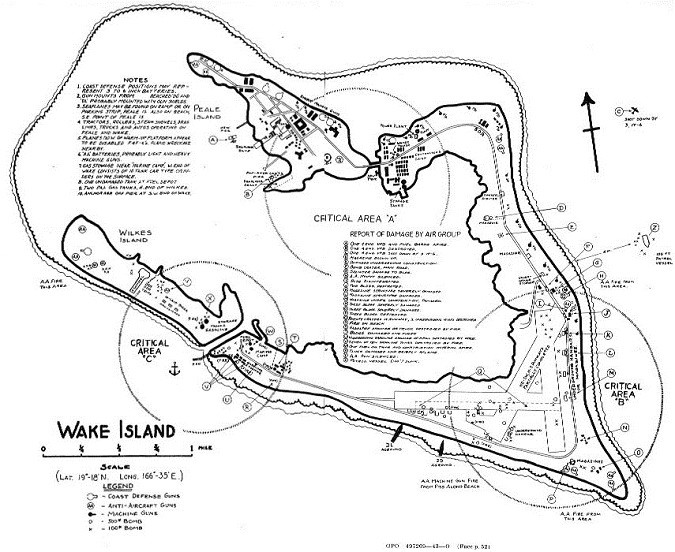
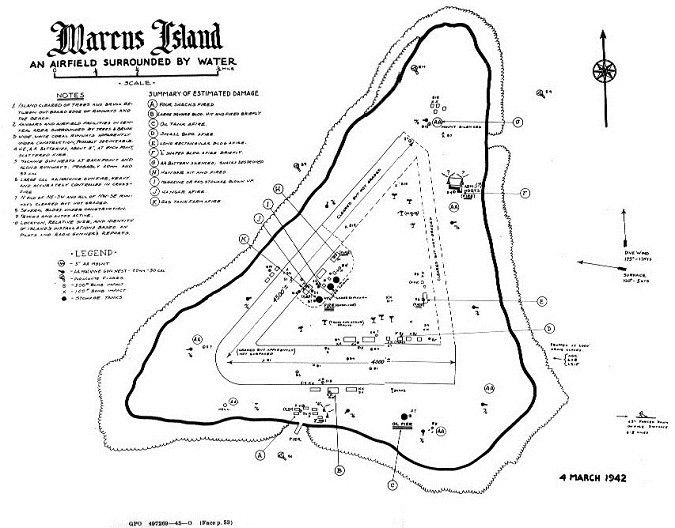
AIR ATTACK ON MARCUS ISLAND
On February 25, 1942, the Commander of Task Force HOW was informed by the Commander in Chief, Pacific Fleet, that, fuel and other considerations permitting, a raid against Marcus Island would contribute to the further effect desired. Marcus is situated at latitude 24°18′ N., longitude 153°58′ E., or about 600 miles northwest of Wake on a line leading directly to southern Japan. It is triangular in shape, about 5 miles in circumference, and has been claimed for many years by the Japanese, who call it Minami Tori Shima. At the time of the attack order it was believed that the island was being used as an administrative center by the enemy, and that it contained radio and weather reporting installations. Landplanes had been sighted near it, indicating an air field.
Three days later Admiral Halsey directed the carrier, Enterprise, and Cruiser Division FIVE (the Northampton and Salt Lake City) to proceed to a point 175 miles northeast of Marcus, to launch an air attack about 1730 March 3d (Greenwich civil time), and to retire at high speed.
The attack was arranged to take place before sunrise on March 4 (zone minus 11 time) in the expectation that the full moon would provide sufficient light for the launching of planes and for rendezvous. Early in the morning of March 4 the Enterprise, in company with the Northampton and Salt Lake City, speed 24 knots, was nearing Marcus on course 235°. Because it was desired to include fighters in the attack, launching of planes was delayed until the ships were about 125 miles from the island. At 0438 the Enterprise changed her course into the wind and a few minutes later the first plane was launched.
The attack group consisted of the air group commander with 14 scout bombers (SBD’s), 17 bombers (SBD’s), and 6 fighters (F4F’s). The bomber and scout planes were armed with one 500-pound (instantaneous fuse) and two 100-pound bombs each. Strong southerly winds prevailed, with a 9/10 overcast of heavy cumulus clouds extending from 4,000 to 8,000 feet. The moon was full.
Because of the heavy overcast and the smallness of the objective, accurate navigation by the attack force was essential. Success was achieved largely through the use of a new method. The Enterprise tracked the planes by radar, informing the group commander of any deviations from
the course to Marcus and telling him just how far he had proceeded on that course. This assistance was of great value for it enabled the planes to proceed above the overcast and yet be confident that they would know when to descend through it and locate the island.
At 6:30 the island was sighted through a break in the clouds, “nestling in the moonlight,” and the order to attack from an altitude of 16,000 feet was given. The surprise was complete. At least four bombs were dropped before any antiaircraft fire was noticed.
The bombing squadron separated into three divisions and began high speed approaches from the south and west. The dives varied in steepness from 045° to 070°, with final dives entered at from 8,000 to 10,000 feet, releases at 3,000 to 2,000 feet in ripple drops, and pull-outs at 1,000 feet with a continued power glide retirement. One plane was detached from the first section just before the attack to reconnoiter the island and broadcast any information available concerning planes on the field or other objectives. Limited strafing was conducted both in the dive and during retirement, the fixed .50-caliber and the flexible .30-caliber machine guns being used.
The scouting squadron followed immediately, some of its planes making a conventional dive bombing attack, approaching from 15,000 feet and entering final dive at about 10,000, while others dived through the clouds and then executed a glide attack.
One plane 6-S-7, pilot Lt. (j.g.) Hart D. Hilton, and gunner J. Leaming, aviation radioman, third class, failed to return from the attack. At 0705 the pilot reported that his plane was on fire and that he was about to land in the water. Lt. Richard H. Best (Bombing Squadron SIX) stated that he saw Hilton’s plane land in the sea about 10 miles east of Marcus, and that the pilot and gunner manned their rubber boat, waved and gave a “thumbs up” signal before he departed from the scene. Lt. Wilmer E. Gallaher, commander of Scouting Squadron SIX, states in his report: “It is believed that 6-S-7 would not have been lost had it been equipped with leak-proof tanks.8 Otherwise no deficiencies in our aircraft armament or equipment were noted.”
Although no enemy aircraft was encountered in the air or sighted on the ground or water, the antiaircraft fire, coming presumably from 3-inch guns located on each point of the island, was sufficiently heavy to prevent close inspection of the damage done. The spotting plane, how-
1 gunboat.
Seriously damaged:
1 seaplane tender.
1 gunboat.
Our only loss was the scout bomber shot down by shore-based enemy antiaircraft fire off Lae. Eleven other planes were slightly damaged (8 scouts and 3 torpedo planes), by antiaircraft shell fragments, or bullets.
The last plane to return from the attack was recovered by the Yorktown at 1201. Retirement was made to the southeastward at 20 knots until dark, when the speed was slowed to 15 knots and a more easterly course taken. No enemy aircraft were sighted by Task Force BAKER
during the 10th, although several strange planes were reported. These were supposed to have been Australian planes operating from Port Moresby. Rendezvous with Admiral Crace’s task group and with the fueling ships was effected as planned on the 14th.
CONCLUSION
While there is no doubt as to the damaging effect of the Lae-Salamaua attack – CINCPAC considered it “well planned and very well executed” – it should not be forgotten that it did not dislodge the Japanese from New Guinea.
The performance of torpedoes was disappointing. Of 13 dropped only 3 could be recorded as certain or probable hits. Under the favorable conditions which prevailed, CINCPAC considered that 9 should have made sure hits.
Subsequent developments did not substantiate the reported sinking of two Japanese heavy cruisers.
Articles you may also be interested in
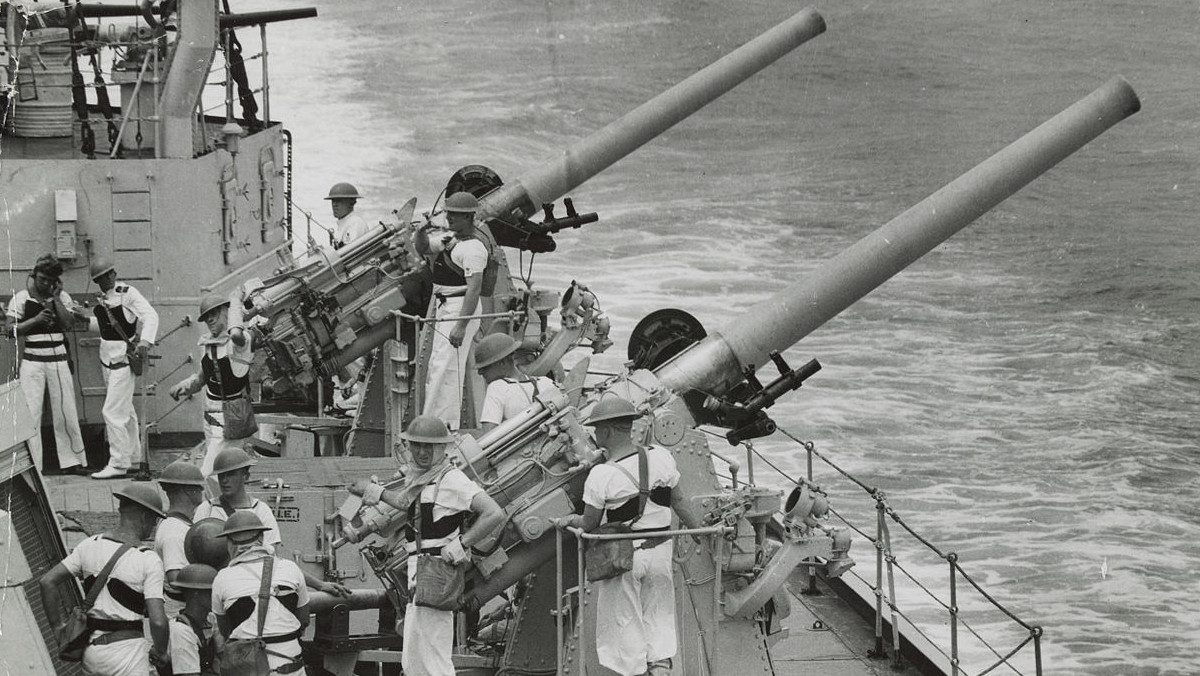
The Battle of Cape Spada: The Australian Navy Proves Its Mettle
Reading time: 9 minutes
The Battle of Cape Spada was a short, violent encounter on the 19th of July, 1940 where the cruiser HMAS Sydney of the Royal Australian Navy sank one Italian cruiser and severely damaged another off the coast of Crete. In this article, we go over the events of that day, as well as what life was like for the crew of the ship.
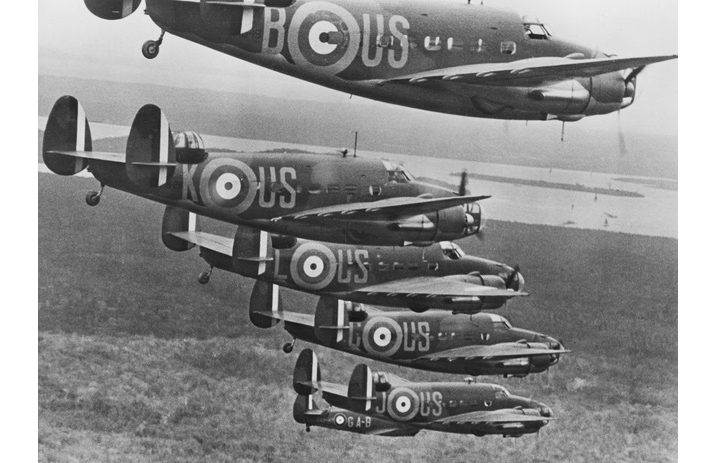
Australia’s first action in the Pacific in World War II a valiant catastrophe
Just before midnight on 7 December 1941, Flying Officer Peter Gibbes stepped off the train at Kota Bharu on the coast of northeast Malaya after a long, tiring journey up the peninsula from Singapore. Gibbes, an airline pilot in peacetime, had been newly posted to the Royal Australian Air Force’s 1 Squadron, which in the […]

